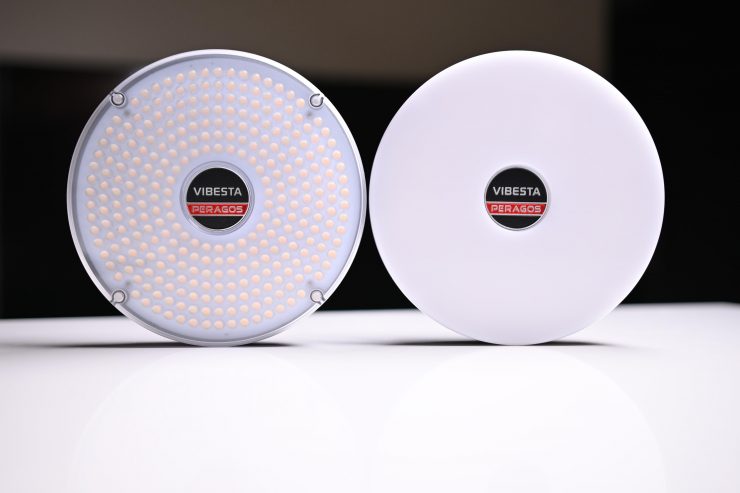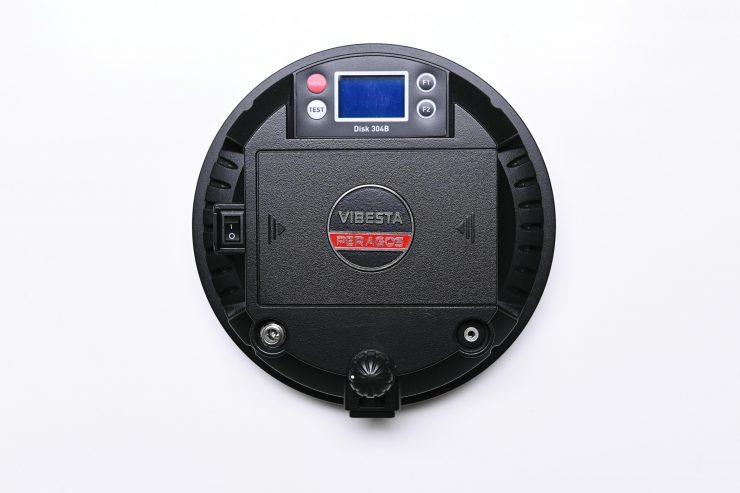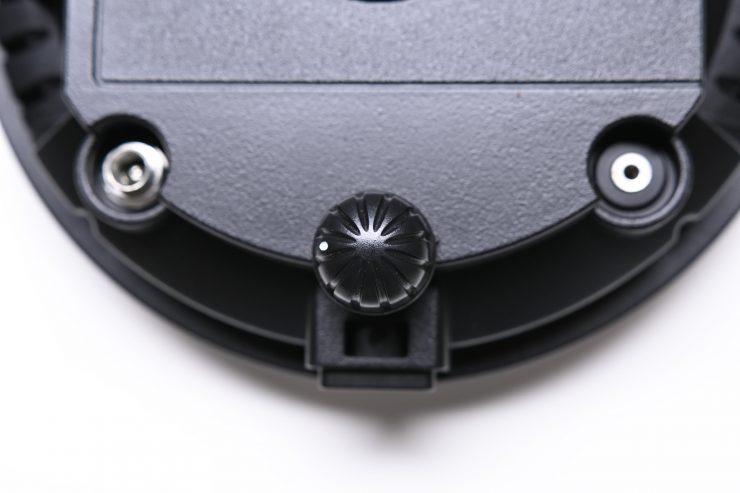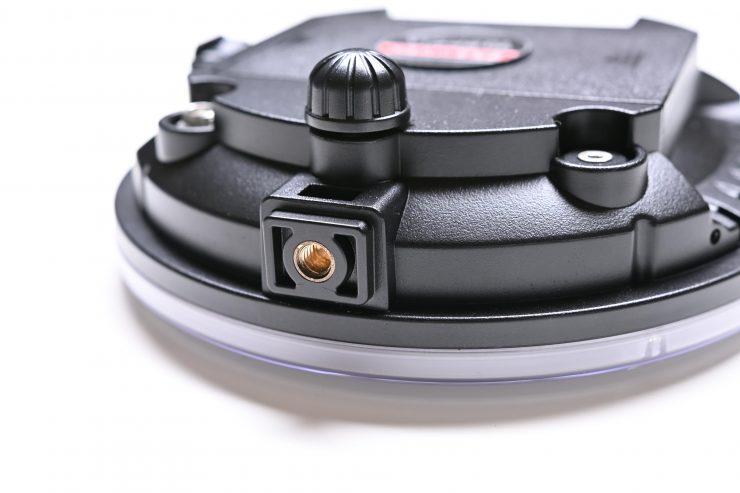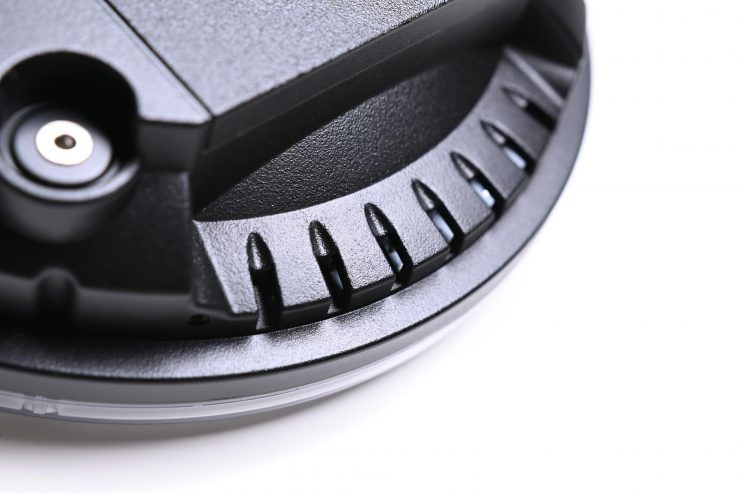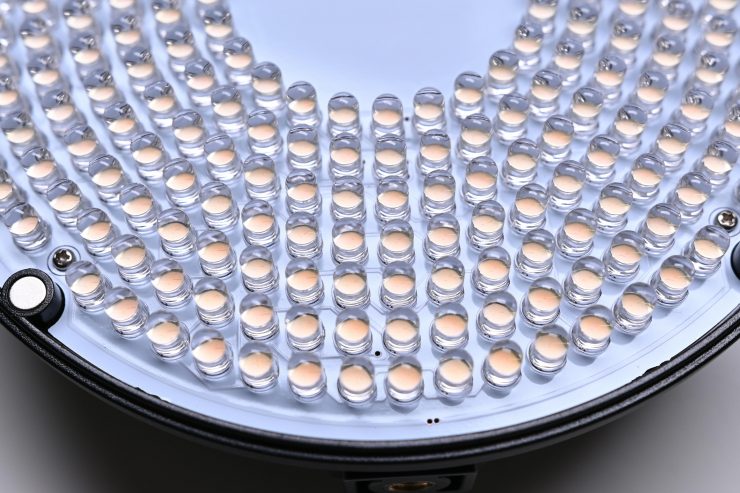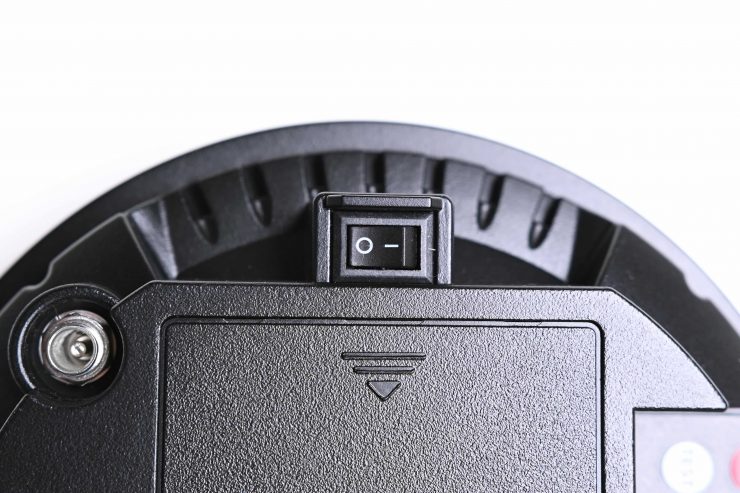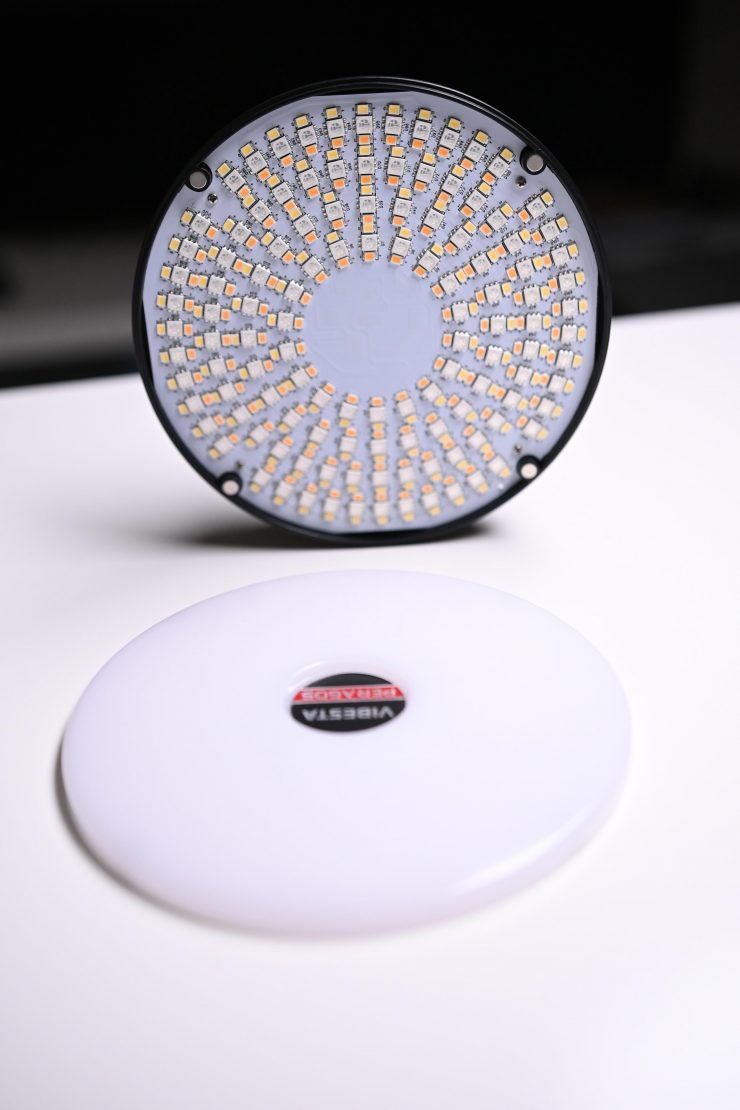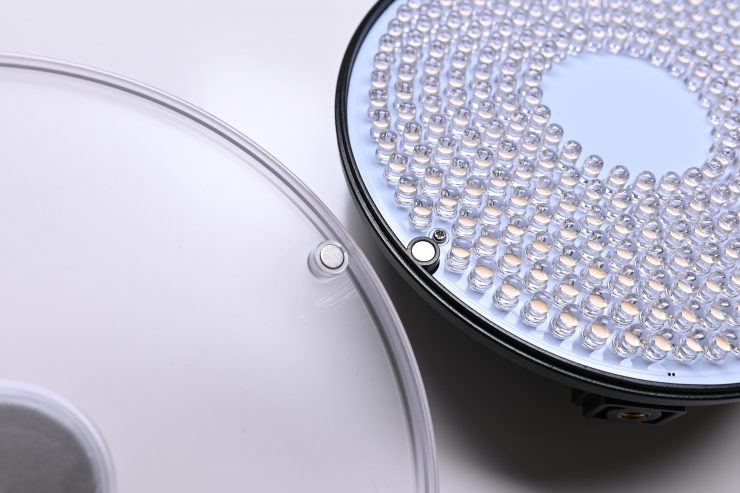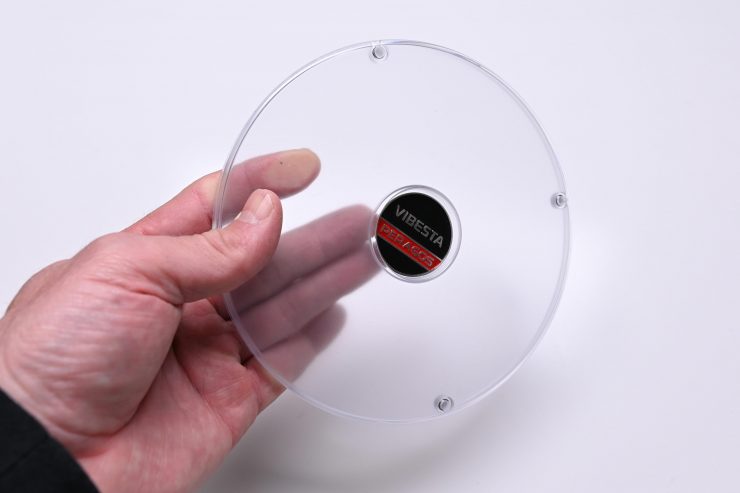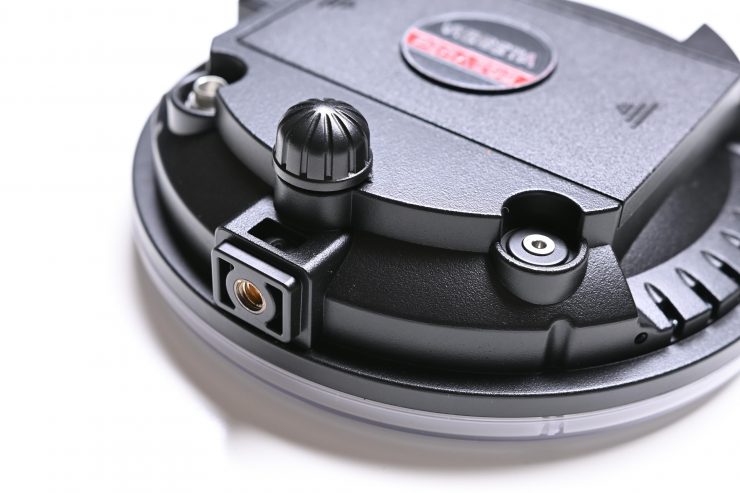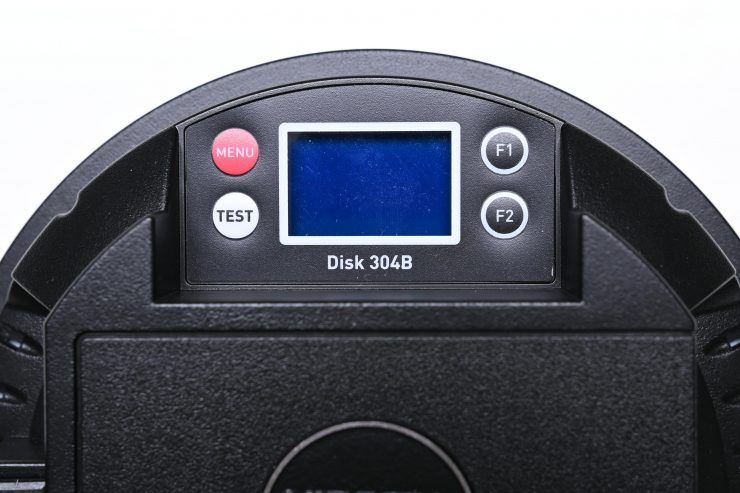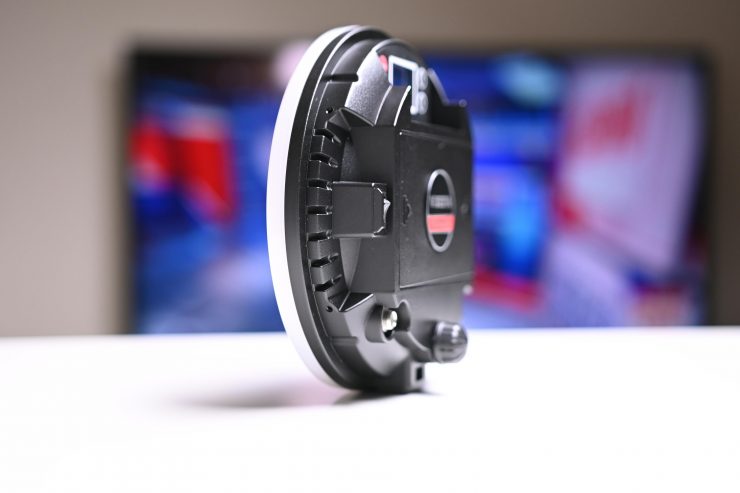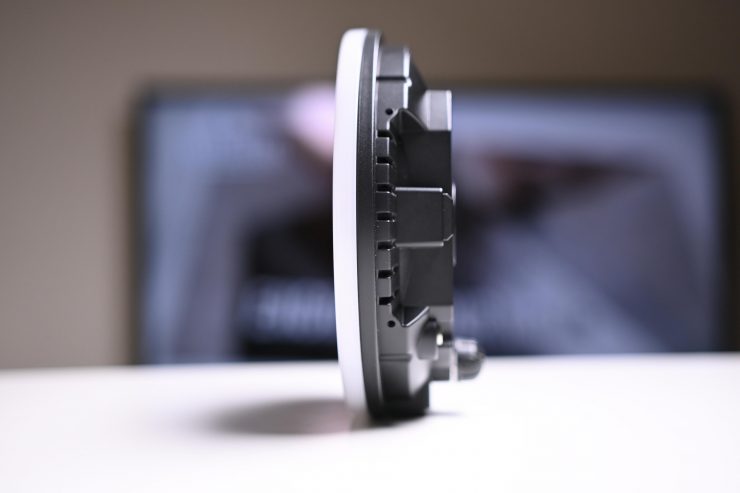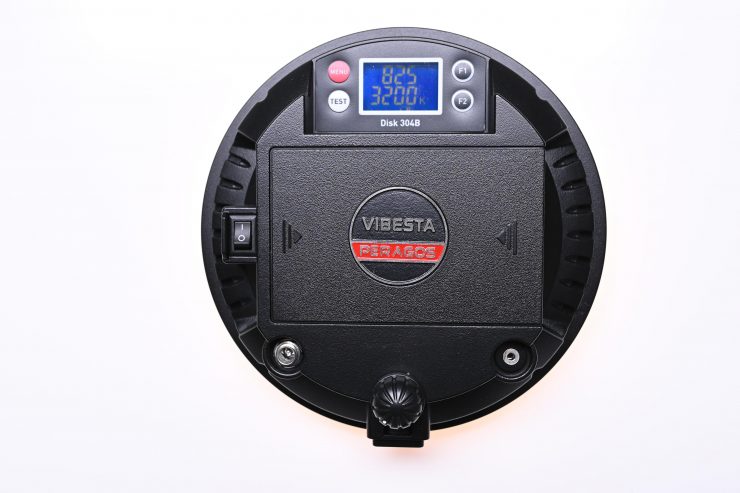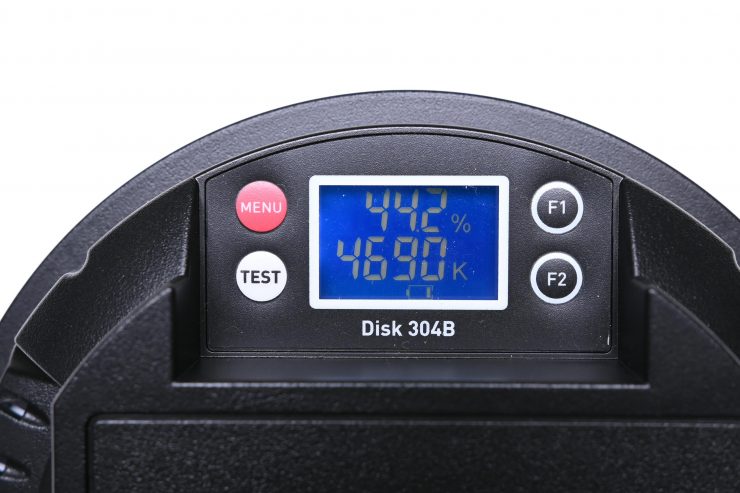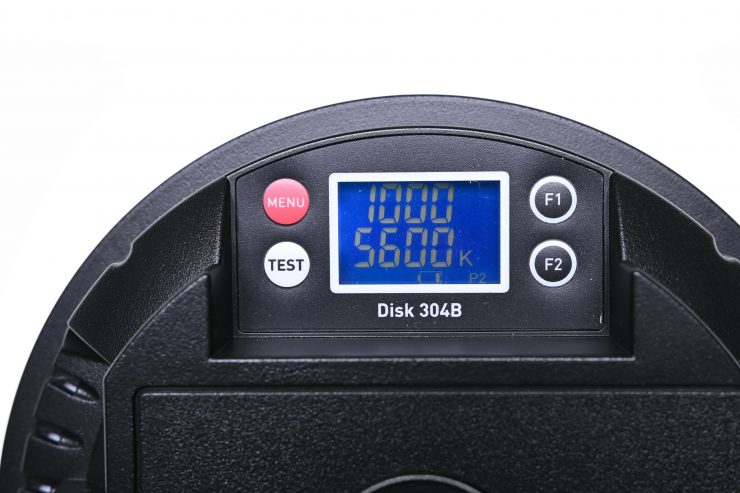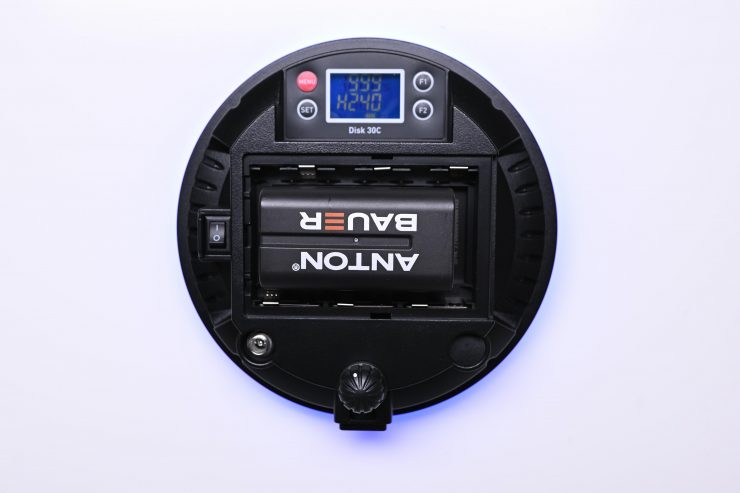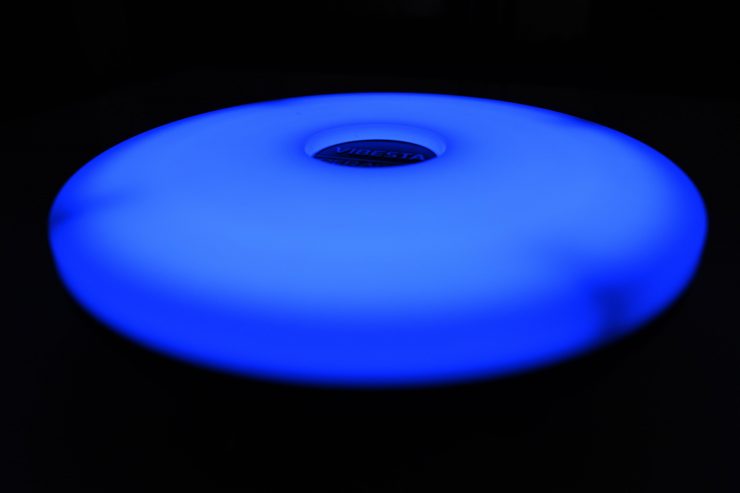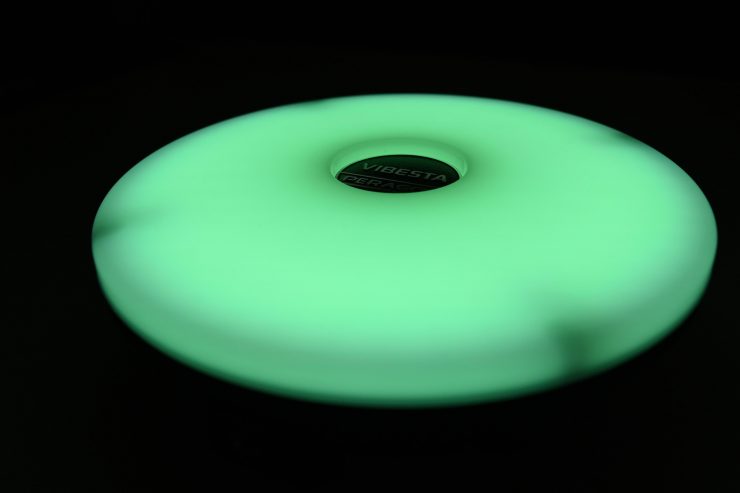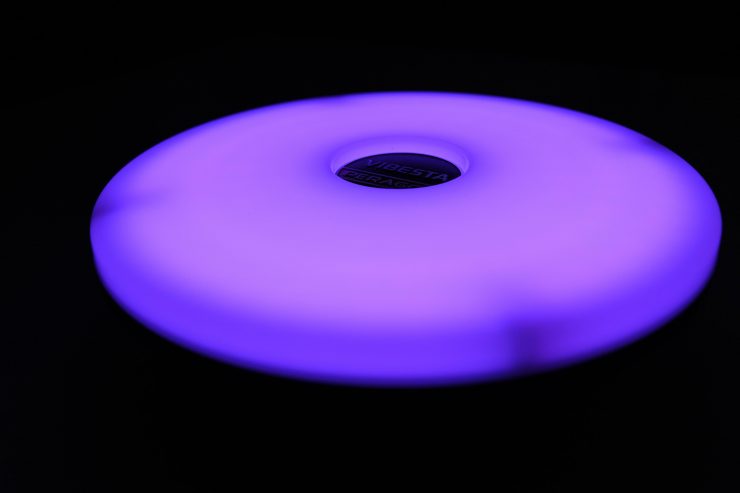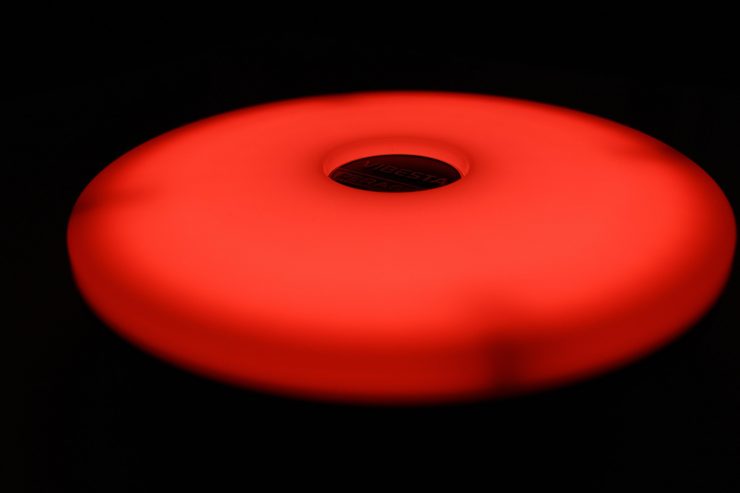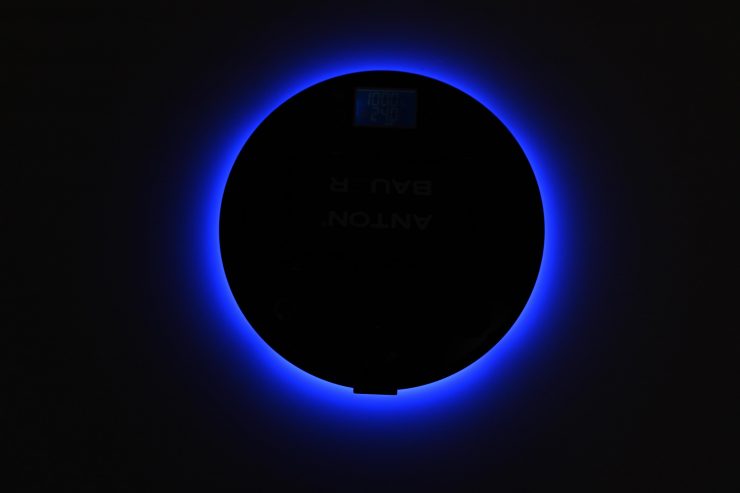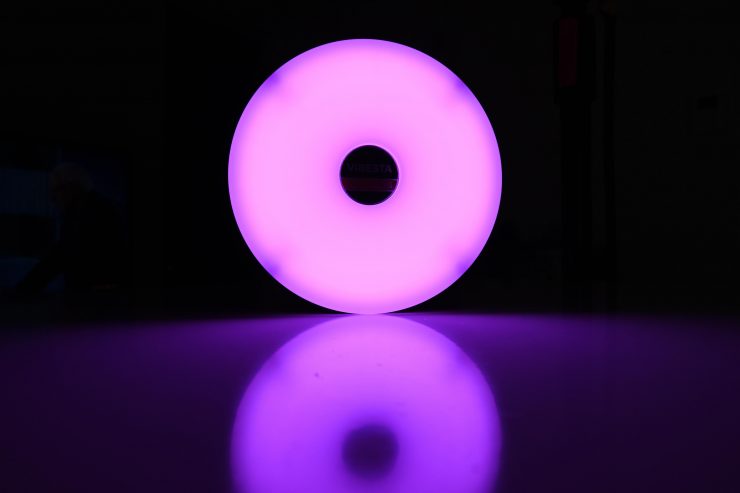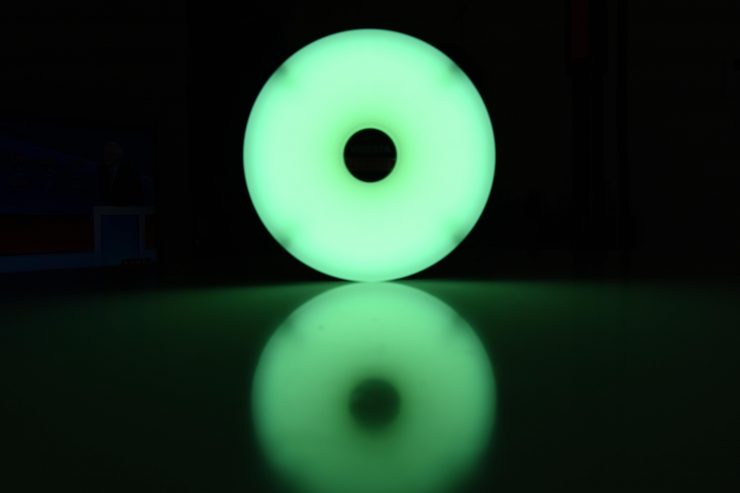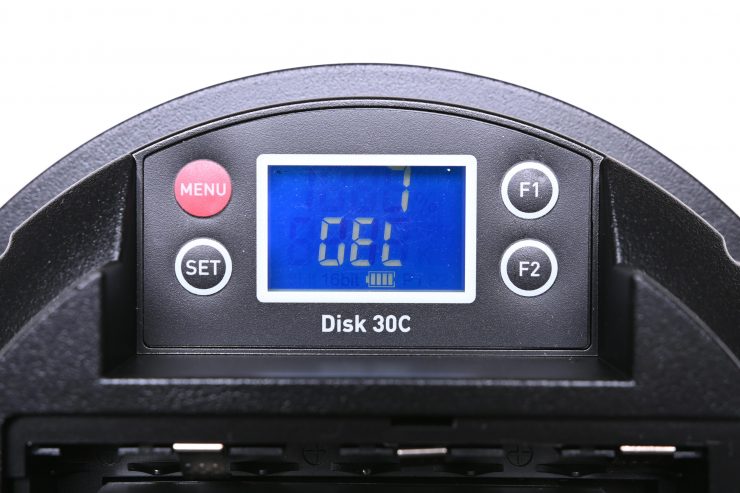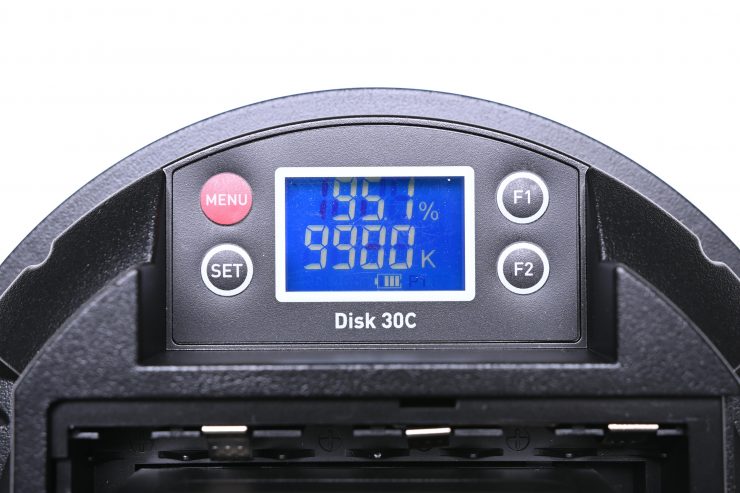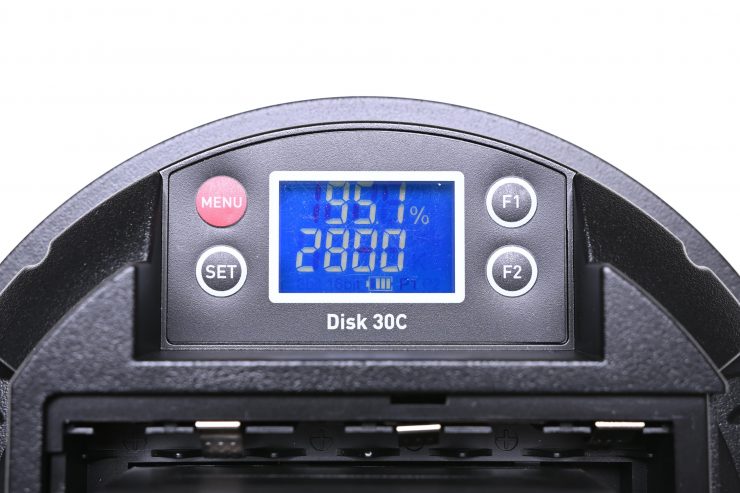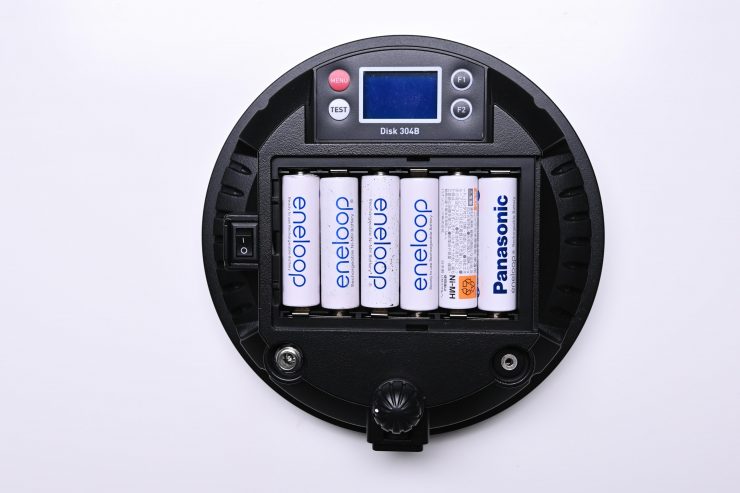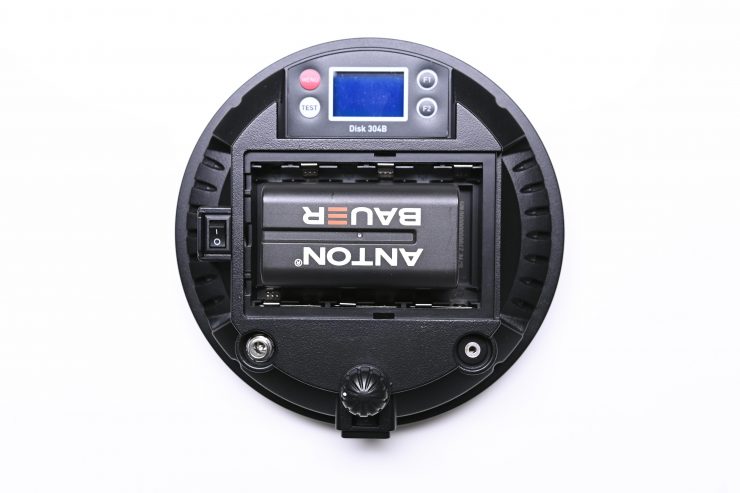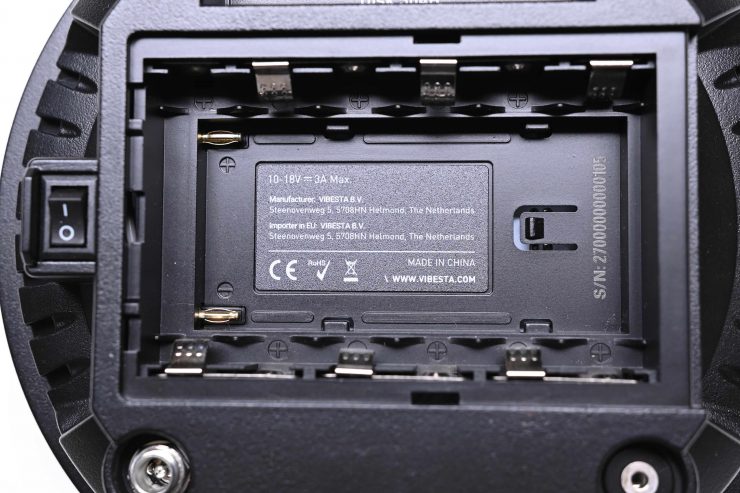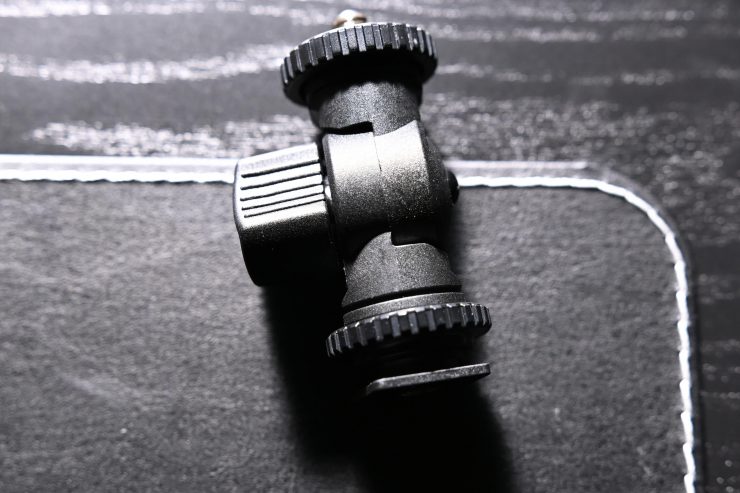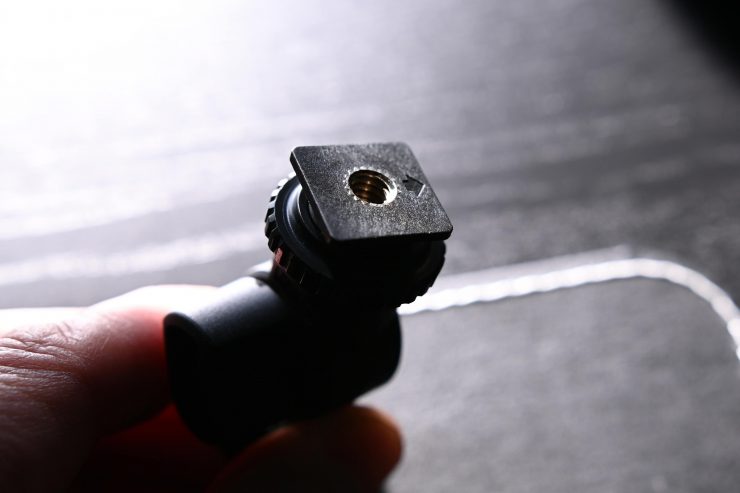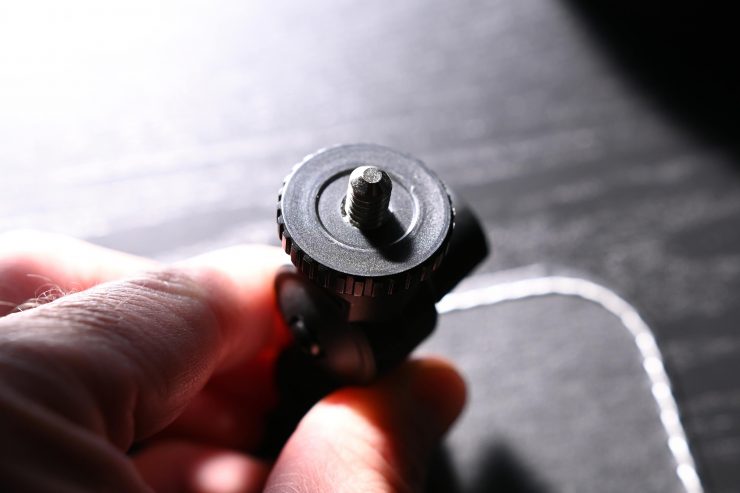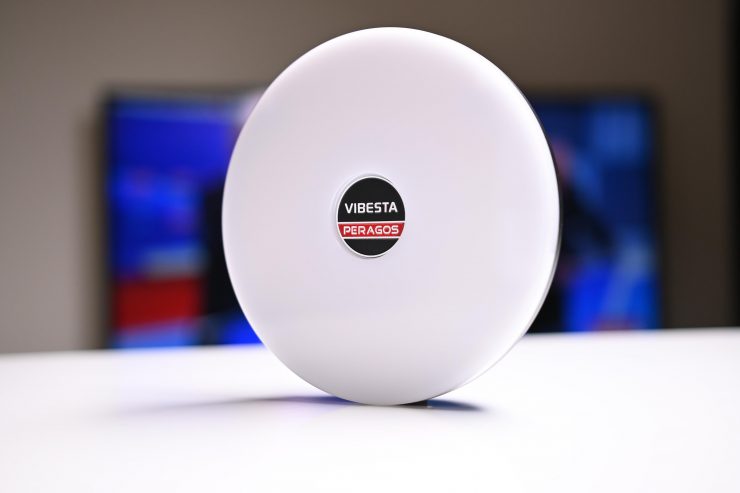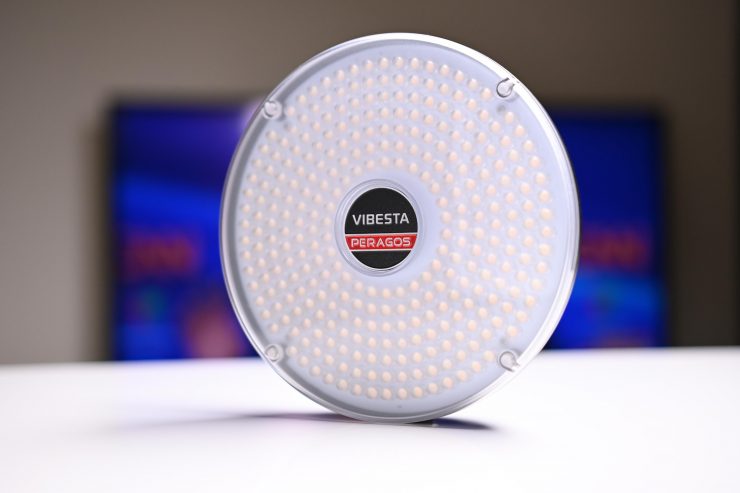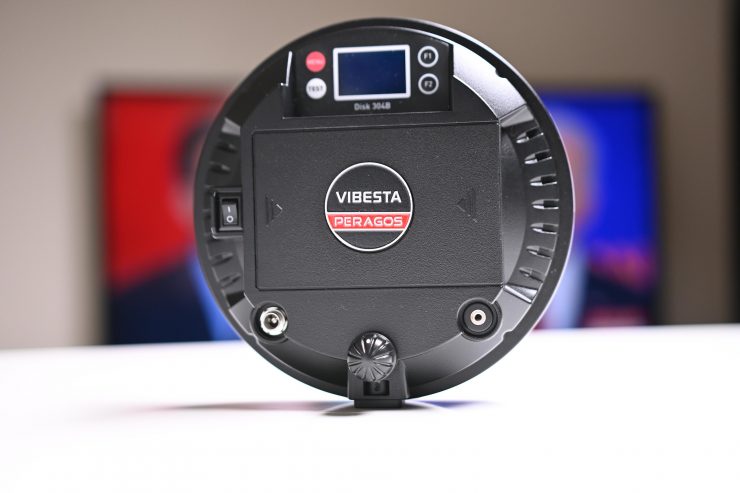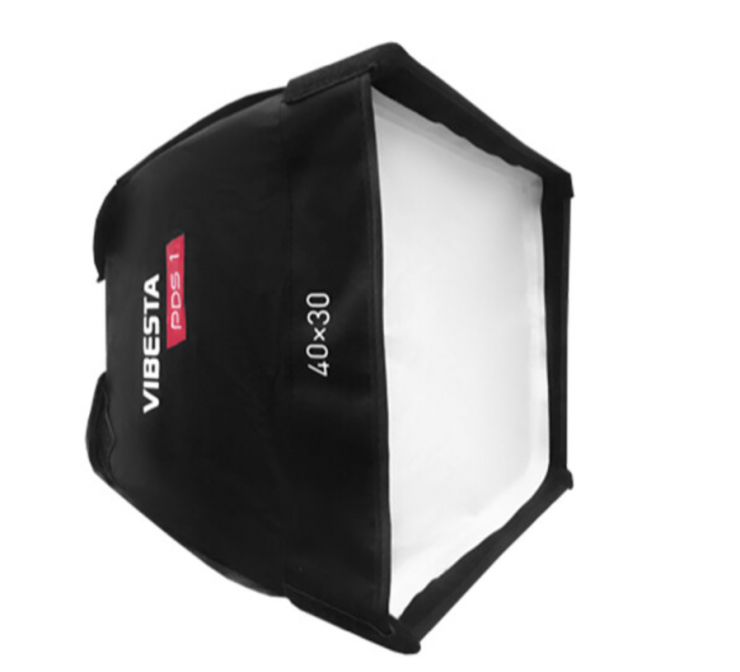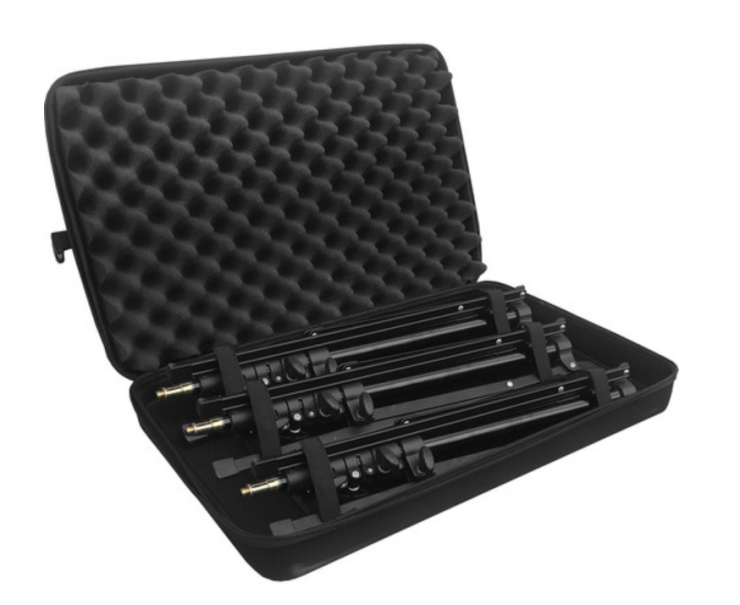
The Vibesta Peragos is a series of compact lights that offer high levels of brightness, full RGBWW control, high-speed flash sync, and wireless control.
There are three different versions of the light available. An RGBWW version, a Bi-color version, and a high output daylight version.
“Perago” in Latin means “to complete the task.”
Who is Vibesta?
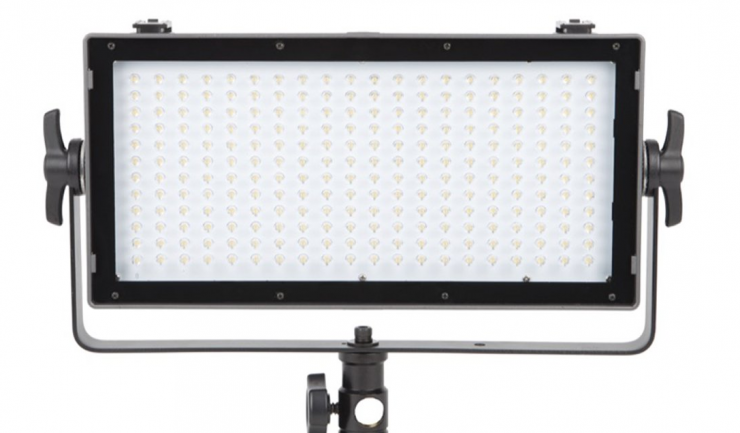
If you are like me you have probably never heard of Vibesta before. Vibesta has actually been around since 2015 and they have brought quite a lot of LED lights to market.
It’s not always hip to be square
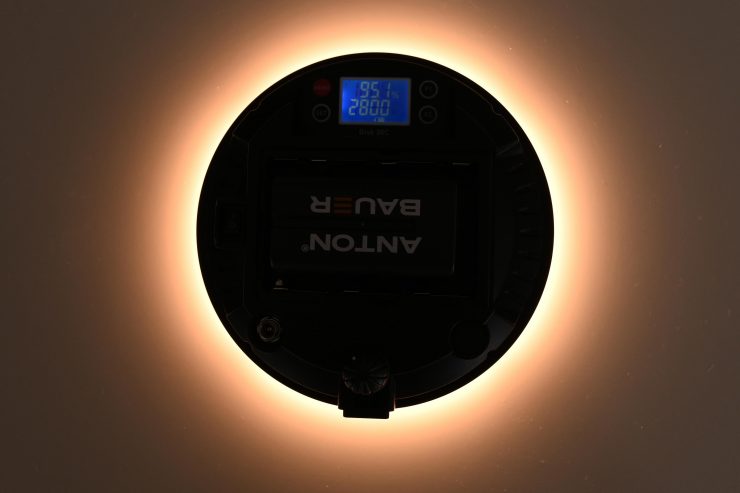
Most panel style LED lights we see are either square or rectangular in shape. There has only been a handful of companies that have made circular LED lights. There are only two other companies that I can think of off the top of my head who have made circular LED lights (if you don’t count ring lights), and that’s Rotolight and Fotodiox.
The whole rationale for making a light round is to create a nice catchlight in the eye. This is exactly why ring lights are used for a lot of beauty shots.
Build quality
The overall build quality of the Vibesta Peragos is pretty good. While the lights are made of a hard plastic material, they don’t feel cheap.
The buttons, dials, and switches all work well and are easy to reach and use.
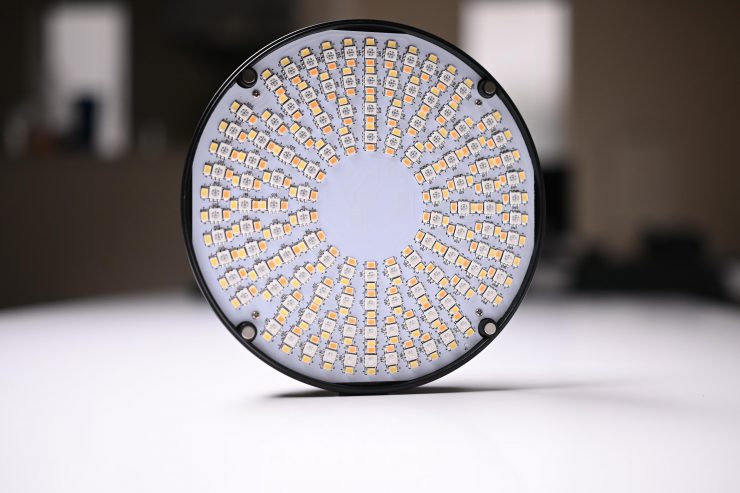
To keep the fixture lightweight and affordable I think Vibesta have struck a reasonable balance when it comes to build quality. While it could be better, I think it is good enough that the lights will hold up to field use.
My only real complaint is that the battery door can be a little difficult to get off.
Weight & Size
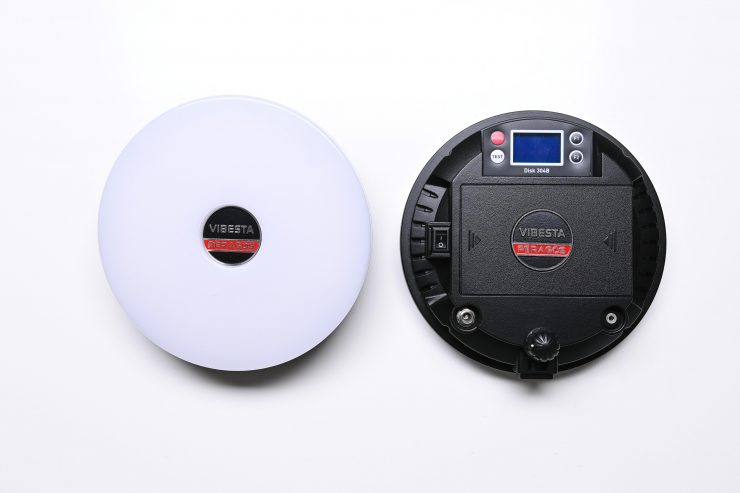
The fixtures are lightweight and they have a small footprint. All three versions of the light weigh in at 370g (13.05oz).
The lights are 160mm (6.3″) wide and 55mm (2.16″) deep.
Who are they aimed at?
Anybody could use these lights, but I think they are certainly being targeted at the Vlogger or users of small, compact mirrorless or digital cinema cameras.
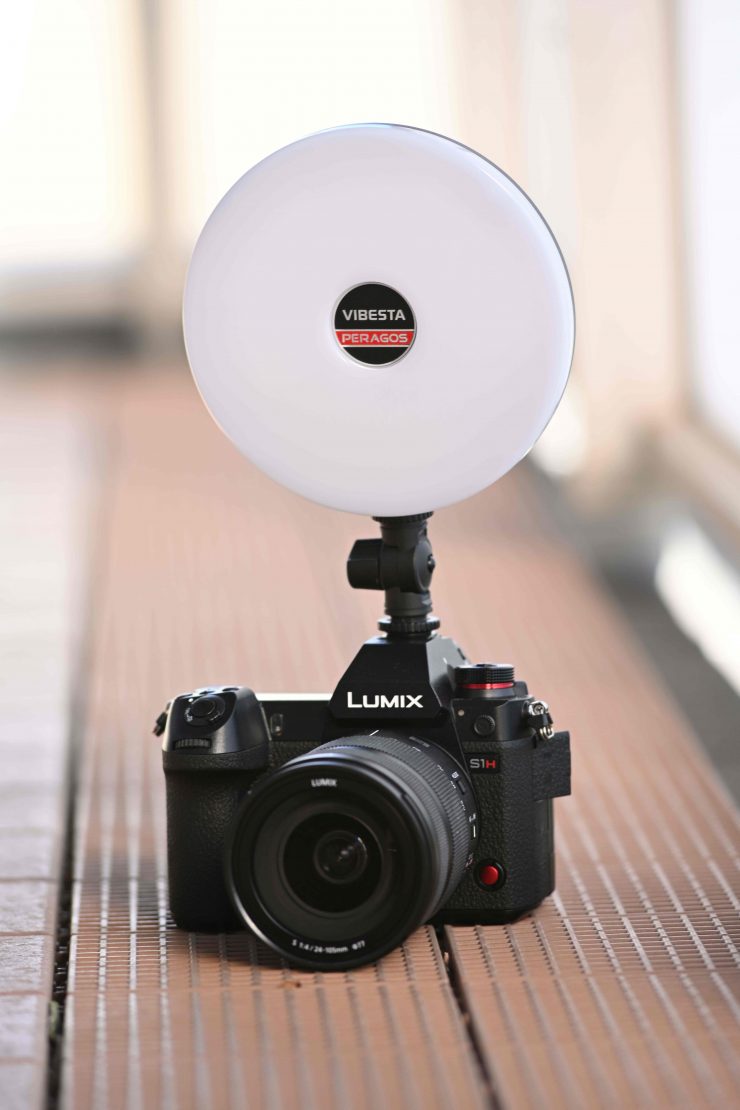
The lights are also a nice alternative if you wanted to use one as an on-camera light.
A set of three could also make for a nice, compact travel lighting kit for those times where you can only take limited amounts of equipment.
What can they do?
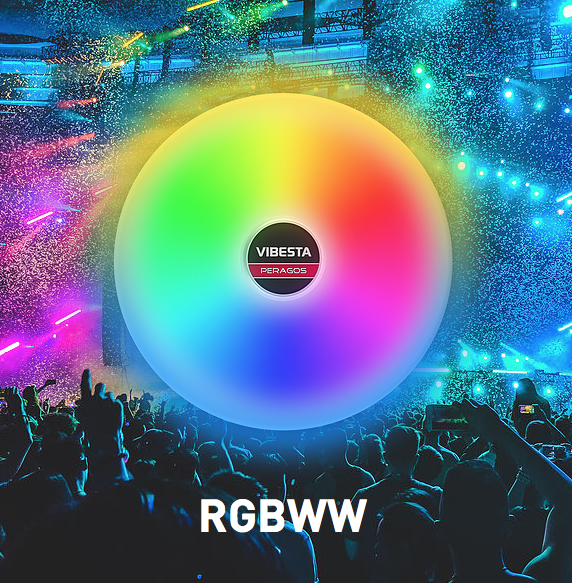
Well, this entirely depends on which model you choose. Vibesta gives you three options:
- RGBWW
- Daylight
- Bi-Color
All three options feature almost an identical design, and they are the same, size and weight. The daylight only fixture, as its name suggests, is 5600K only. It has a very narrow beam angle of 30° and a power draw of 24W.
The Bi-Color version is Kelvin color adjustable from 3200K to 5600K. It has a narrow beam angle of 50° and it draws 24W.
Both the Daylight and Bi-Color have a Flash mode that doesn’t have any recycle time and allows the fixtures to operate at 200% of the maximum continuous light output to freeze action shots. This feature isn’t available in the RGBWW version.
The RGBWW version has an HSI Mode, 160 built-in digital gel filters, and an impressive 2400K to 9900K Kelvin color temperature range.
Unlike the Daylight and Bi-Color versions, the RGBWW version has a very wide beam angle of 120° and a power draw of 30W.
Wireless Control
All of the lights can be wirelessly controlled. The fixtures have a built-in wireless receiver so that they can be controlled by any ArtNet compatible app with the optional RTX1 wireless router.
While this is a nice feature, I can’t see too many users of low cost lights such as this buying an optional router and paying $99 USD to buy something like Luminair 3.
On a small, affordable light you really need a free app. Luxli has done it with their Viola², so it can certainly be done. I know that developing your own app can be expensive, but for small on-camera style lights that are aimed at a certain target audience, nobody is going to want to use a router and have to set up a DMX network.
How is it powered?
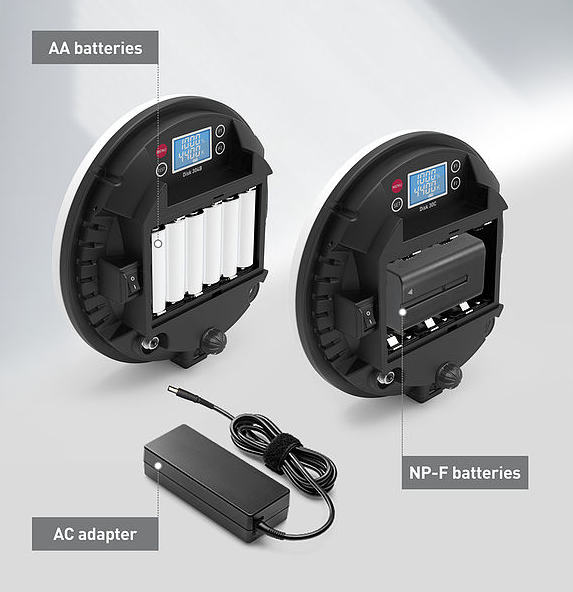
You can power the Peragos disks by NP-F type batteries, normal AA batteries or via an AC adapter.
I like how this has been designed. It’s great to have options when it comes to powering and by making the battery plate dual purpose it lets you use the powering solution you want.
It is also nice that you can use an AC adapter to power the lights off mains power.
Mounting Points
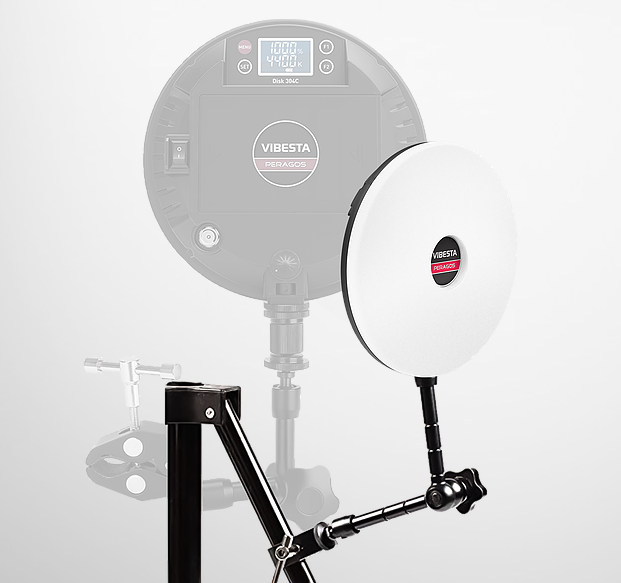
The mounting options are quite limited with the Peragos lights. They only have a single 1/4 20″ option that is located on the bottom of the light.
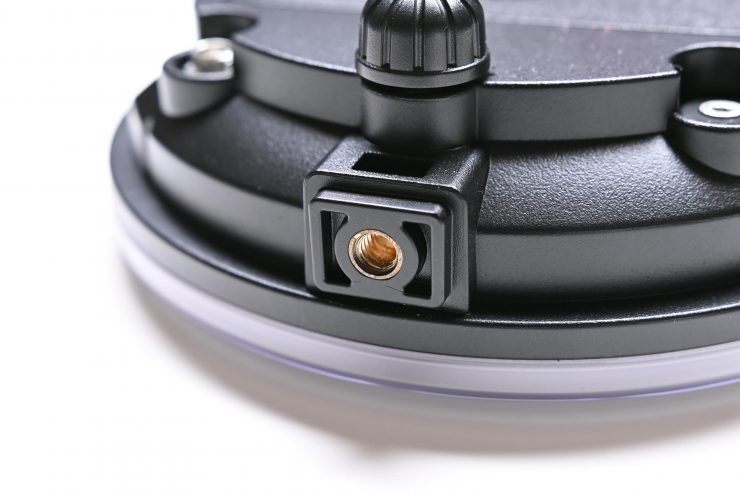
To be fair, on a small, circular light, you really don’t need anything more than a single mounting point.
The fixtures also come with a small ball head to cold shoe adapter. On the bottom of the cold shoe is also a 1/4 20″ receptor so you can mount it to a monitor arm or light stand while maintaining the benefits of having a ball head.
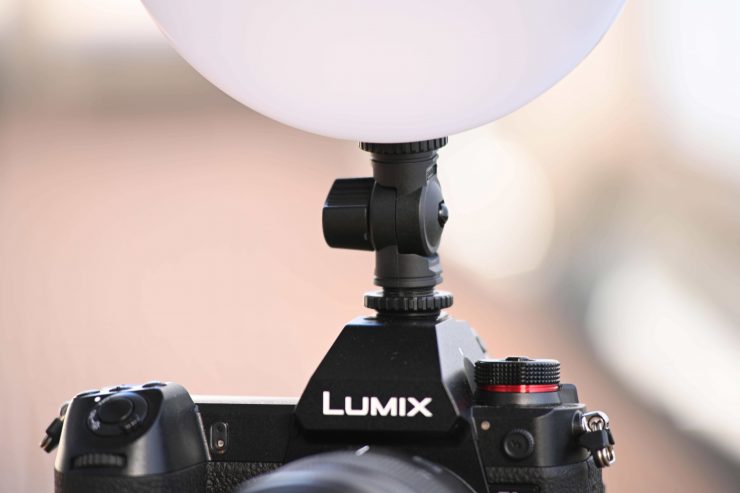
The ball head adapter is lightweight, but it locks off very tightly and can easily support the weight of the light. I like that it features a ratchet-style design as it won’t slip when you are making adjustments.
Ease of use
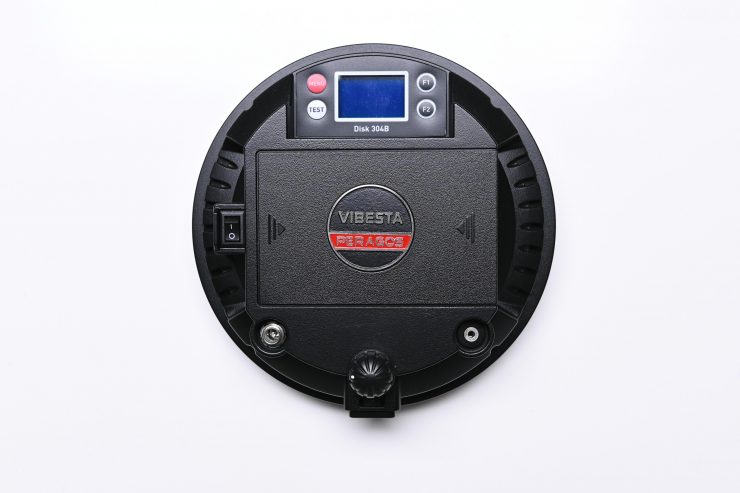
The lights are simple and easy to use. They don’t have complex menus and making changes to settings is very straight forward.
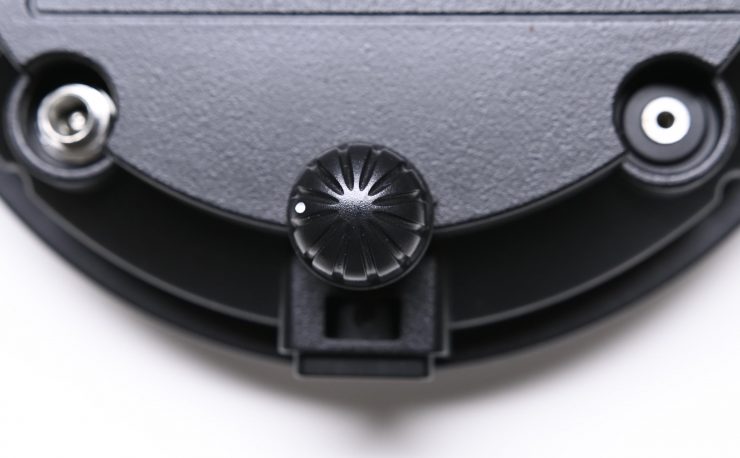
By pressing once on the intensity dial you can switch between the color temperature and output and then make your adjustments.
With the RGBWW version, it is very easy to toggle between the normal operating mode, HSI and Gel modes.
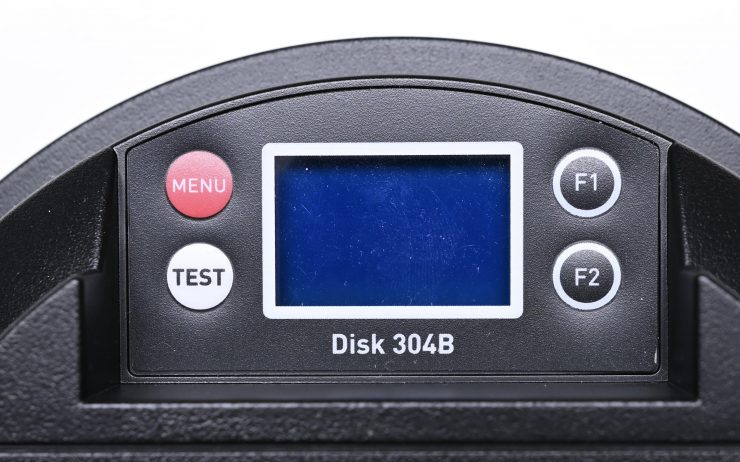
I like that there are also two function buttons that you can use to store presets.
Output
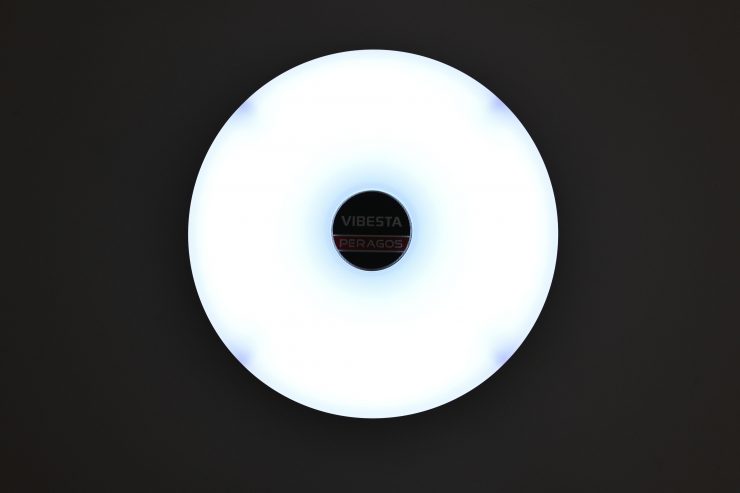
This is where most small, compact and portable light fall over. I have yet to come across a light that falls in this category that I would personally consider bright enough to use as a key light in an interview situation. There are bound to be plenty of people who will argue with me about this, but I think that a light needs a minimum output of 2000 lux at a distance of 1 meter to be useable for a lot of interview scenarios.
Sure you could get away with a light with a lot less output, but try using one to match any type of mildly bright background without having to place it 2 feet from your subjects head.
So how does the Vibesta Peragos perform when it comes to output? I measured the Daylight, Bi-Color, and RGBWW versions at a distance of 1m in a controlled environment with a Sekonic C-800. I did readings with both the front diffusion filters on and with them removed.
5600K
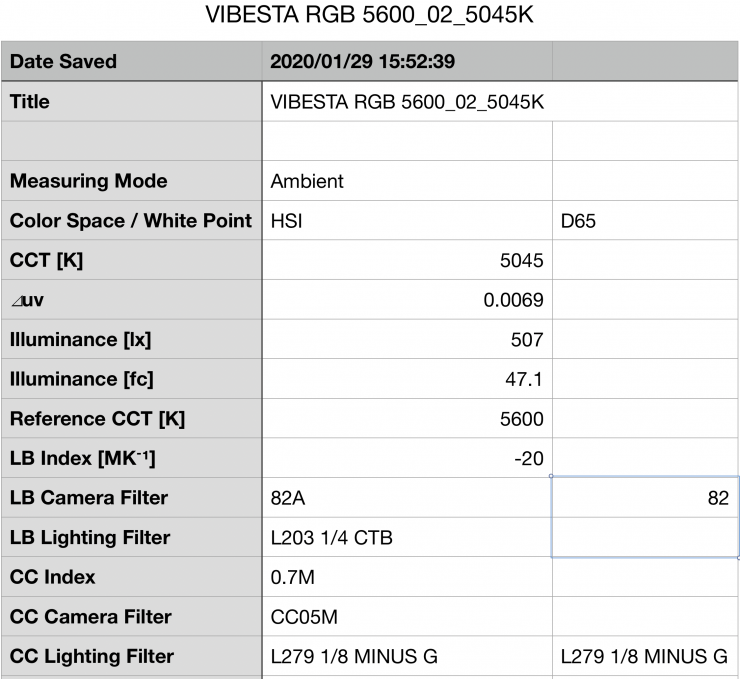
Above you can see that the Vibesta Peragos RGBWW version when set at 5600K, produced an output of 507lx (47.1fc) at a distance of 1m (3.28ft). It also recorded a Kelvin color temperature of 5045K.
Without the diffusion cover on it recorded an output of 1060lx (98.5fc).
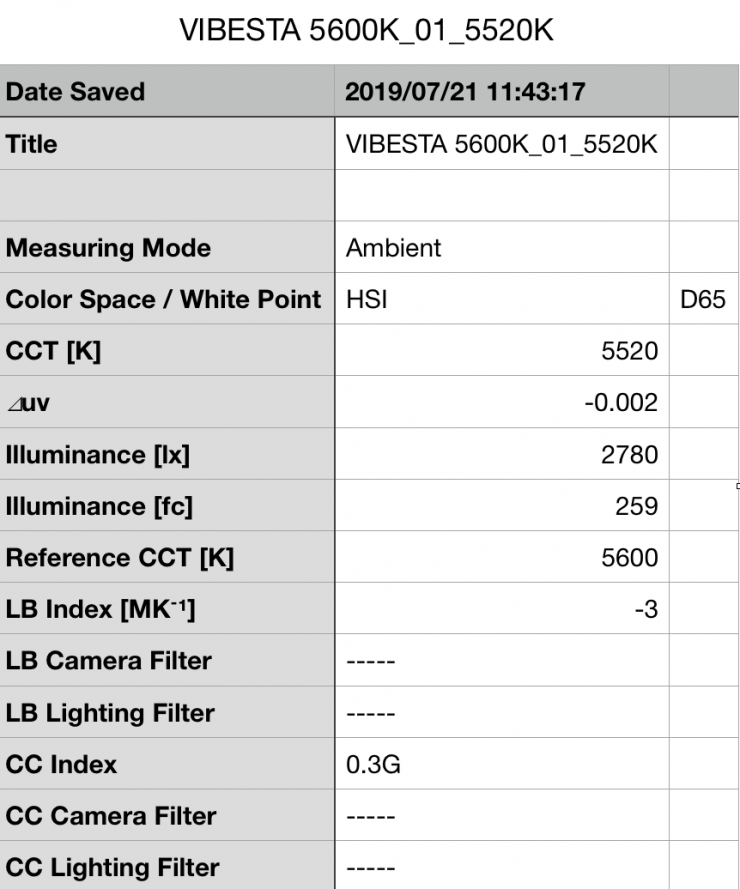
Above you can see that the Vibesta Peragos Daylight version when set at 5600K, produced an output of 2780lx at a distance of 1m (3.28ft). It also recorded a Kelvin color temperature 5520K.
Without the front diffusion filter, it recorded an output of 3650lx.
These output figures were extremely impressive for such a small light. What you do need to keep in mind is that the beam spread is a very narrow 30°.
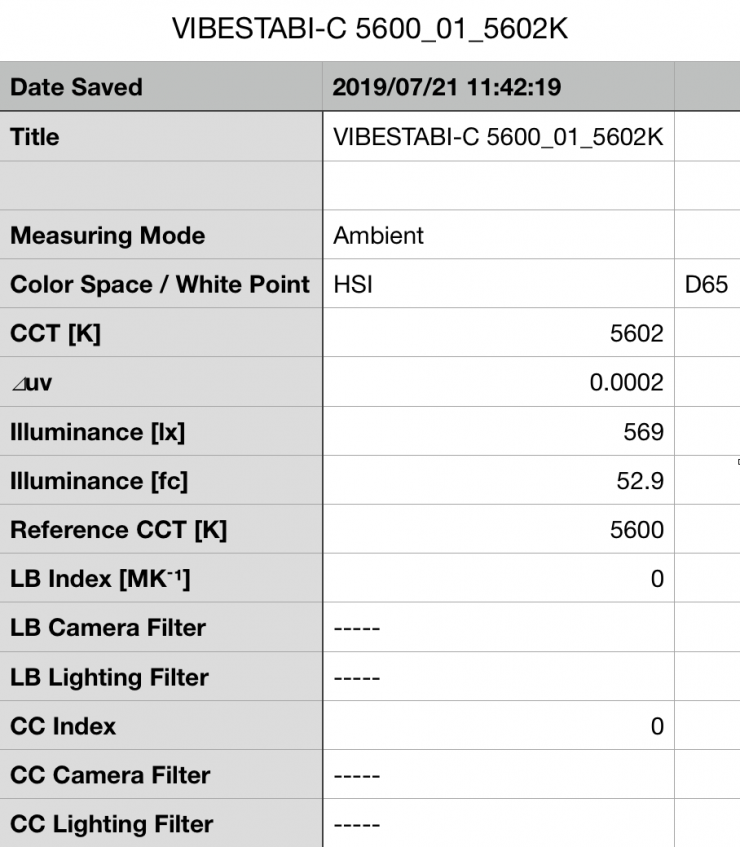
Above you can see that the Vibesta Peragos Bi-Color version when set at 5600K, produced an output of 569lx at a distance of 1m (3.28ft). It also recorded a Kelvin color temperature 5602K.
This output at 5600K was very low, and way lower than the claimed 1123lx quoted by the company. This figure puzzled me, but it looks like that figure being quoted was for using the light without the front diffusion filter. I decided to measure the light without the front diffusion filter and I found it had an output of 998lx.
While it is nice that you can use the fixture without a diffusion filter, you can’t really use it like this if you are filming a person. The light is uncomfortable to look at.
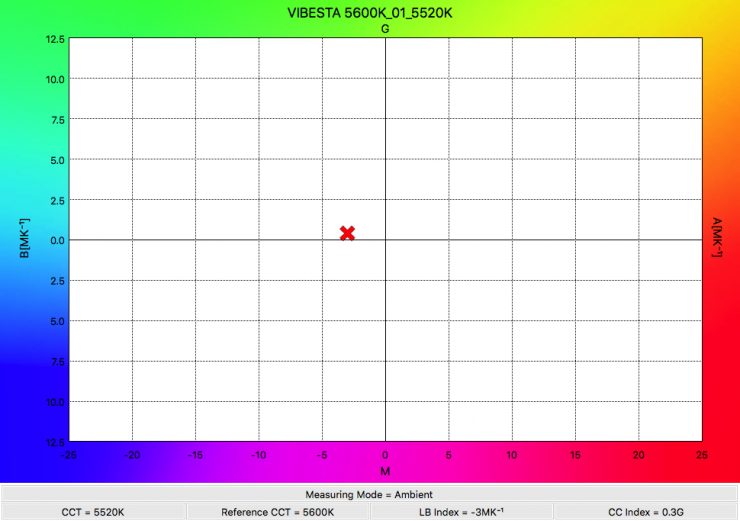
The recorded Kelvin color temperature of 5602K was extremely impressive.
3200K
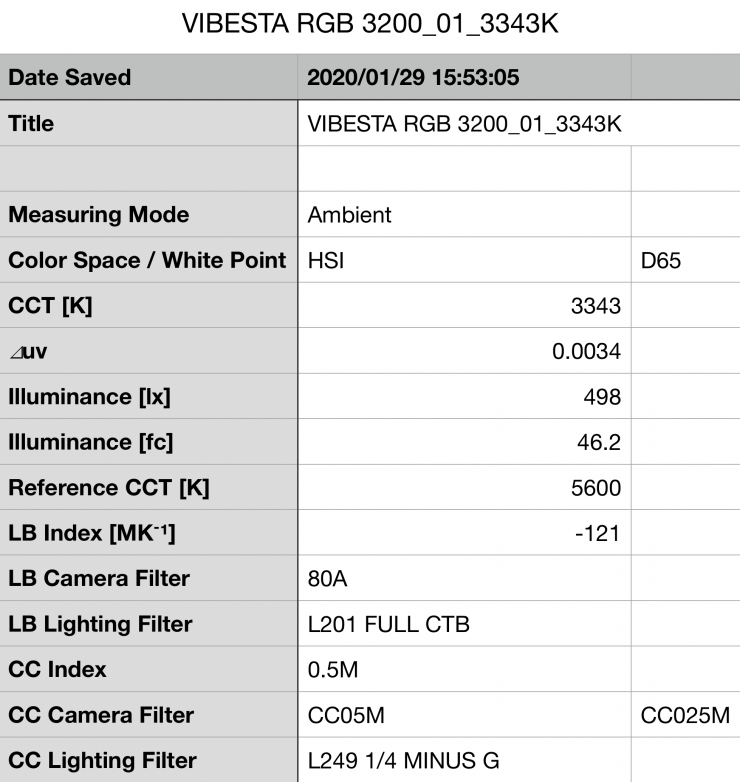
Above you can see that the Vibesta Peragos RGBWW version, when set at 3200K, produced an output of 498lx (46.2fc) and a Kelvin color temperature of 3343K.
With no diffusion used it recorded an output of 1050lx (97.9fc).
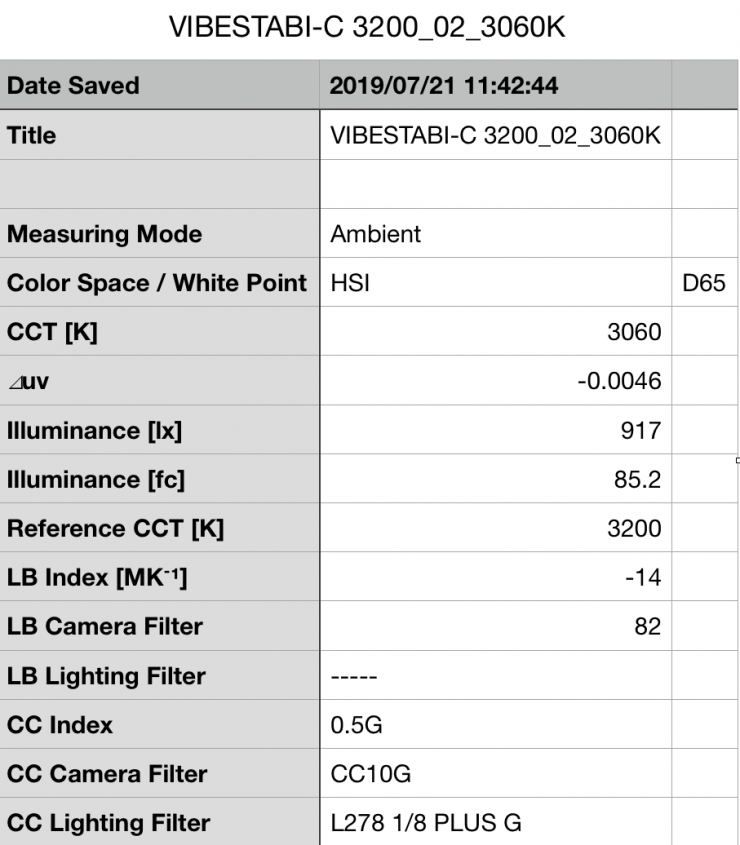
Above you can see that the Vibesta Peragos Bi-Color version when set at 3200K, produced an output of 917lx at a distance of 1m (3.28ft). It also recorded a Kelvin color temperature 3060K.
So how does the Bi-Color version compare to its closest competitor the Rotolight NEO 2? Below you can see the output and Kelvin color temperature results for the NEO 2.

Above you can see that the Rotolight NEO 2 when set at 5600K, produced an output of 1040lx at a distance of 1m (3.28ft). It also recorded a Kelvin color temperature 5667K.
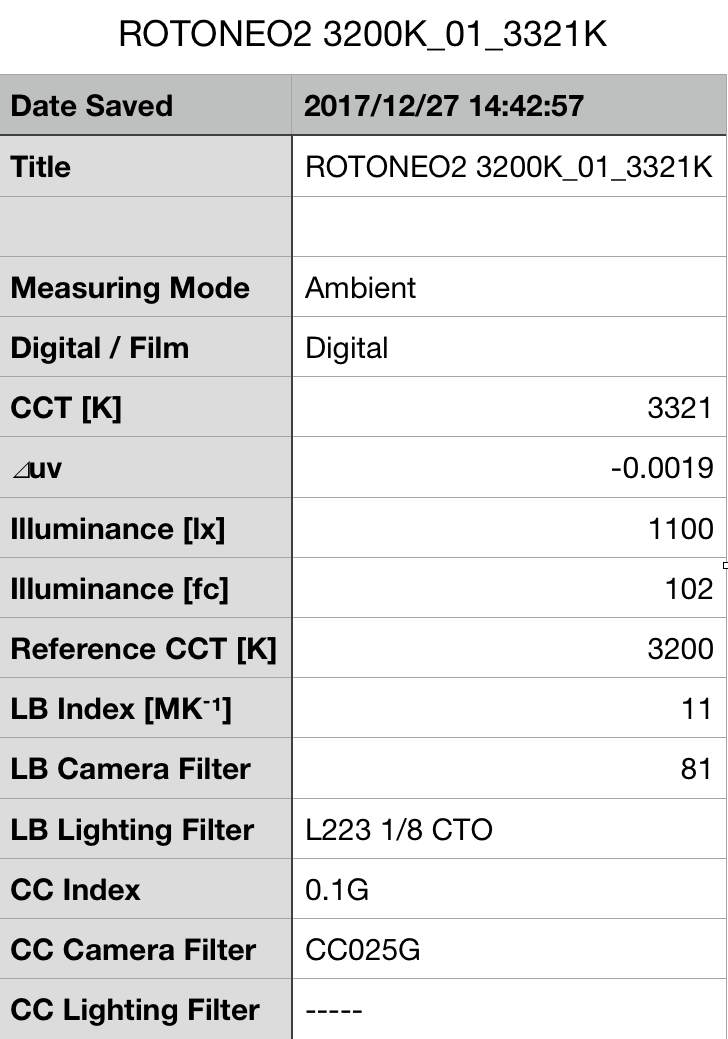
Above you can see that the Rotolight NEO 2, when set at 3200K produces an output of 1100lx at a distance of 1m (3.28ft). As far as accurately reproducing a 3200K source, the NEO 2 recorded 3321K.
So in summary, this is how the Vibesta Peragos Bi-Color compares to the Rotologht NEO 2.
5600K
| Vibesta Peragos Bi-Color | Rotolight NEO 2 |
| Output: 569lx (998lx no diffusion) | Output: 1040lx |
| Kelvin Color Temperature: 5602K | Kelvin Color Temperature: 5667K |
| CC Index: 0 | CC Index: 0.3G |
| UV: 0.0002 | UV: -0.0024 |
3200K
| Vibesta Peragos Bi-Color | Rotolight NEO 2 |
| Output: 917lx (1230lx no diffusion) | Output: 1100lx |
| Kelvin Color Temperature: 3060K | Kelvin Color Temperature: 3321K |
| CC Index: 0.5G | CC Index: 0.1G |
| UV: -0.0046 | UV: -0.0019 |
The Rotolight NEO 2 is brighter at both 3200K and 5600K, while the Vibesta is slightly better at replicating a 5600K source, the Rotolight is more consistent across the 3200K- 5600K range.
Color Rendering
Now that we have seen output and Kelvin color accuracy, let’s have a look at color rendering.
5600K
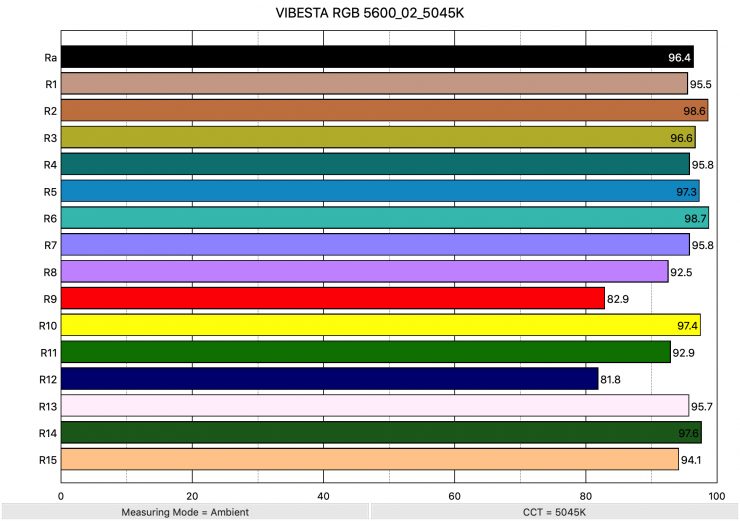
Above you can see the color rendering scores for the Vibesta Peragos RBGWW when it was set at 5600K. The light had an average CRI (R1-R8) of 96.4, and an extended CRI (R1-R15) of 94.2. The light recorded a TLCI of 98.
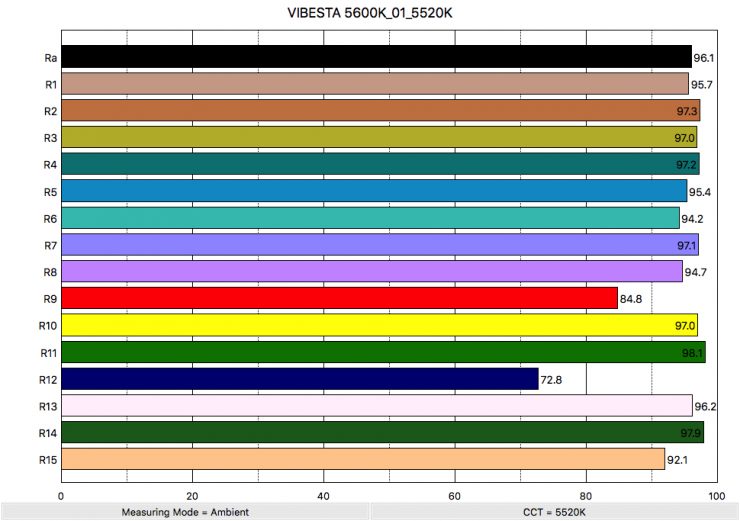
Above you can see the color rendering scores for the Vibesta Peragos Daylight. The light had an average CRI (R1-R8) of 96.1 and an extended CRI (R1-R15) of 93.83. The light recorded a TLCI of 97.
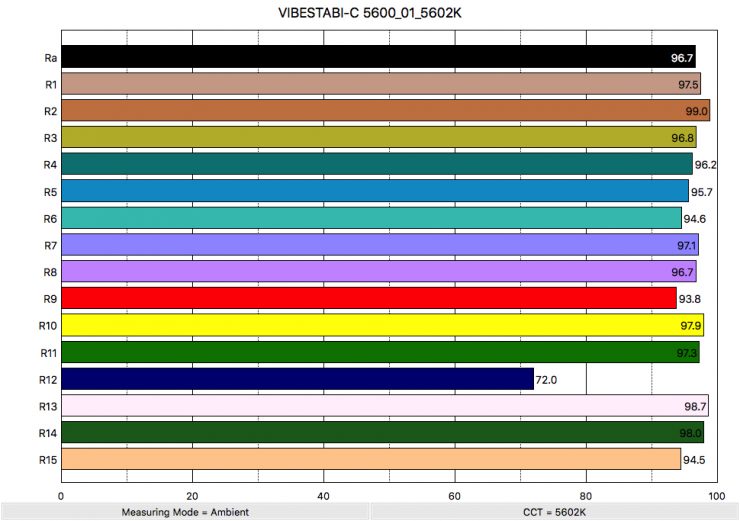
Above you can see the color rendering scores for the Vibesta Peragos Bi-Color when it was set at 5600K. The light had an average CRI (R1-R8) of 96.7 and an extended CRI (R1-R15) of 95.05. The light recorded a TLCI of 97.
3200K
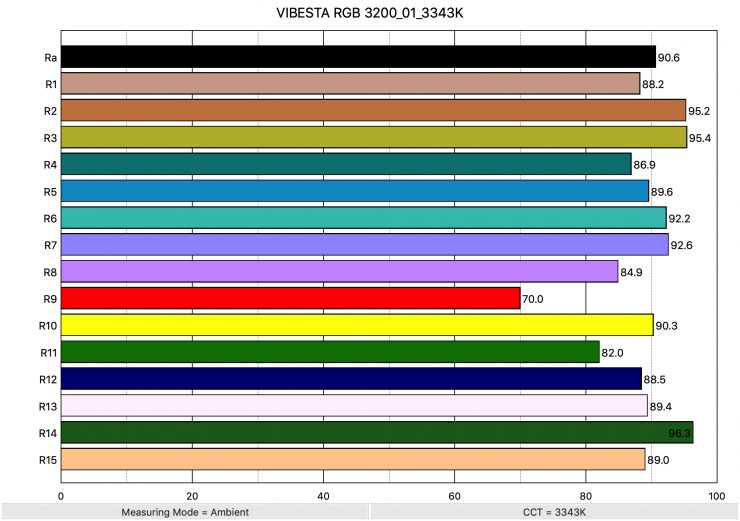
Above you can see the color rendering scores for the Vibesta Peragos RGBWW when it was set at 3200K. The light had an average CRI (R1-R8) of 90.6 and an extended CRI (R1-R15) of 88.7. The light recorded a TLCI of 93.
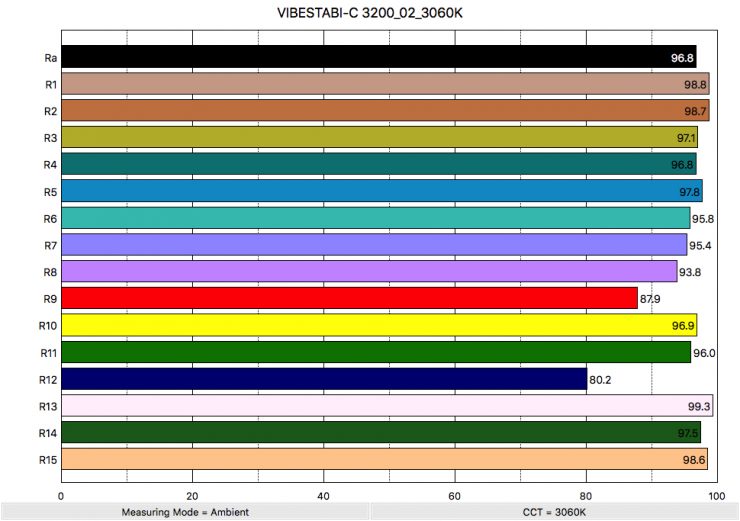
Above you can see the color rendering scores for the Vibesta Peragos Bi-Color when it was set at 3200K. The light had an average CRI (R1-R8) of 96.8 and an extended CRI (R1-R15) of 95.37. The light recorded a TLCI of 96.
So how does that compare to its closest competitor the Rotolight NEO 2?
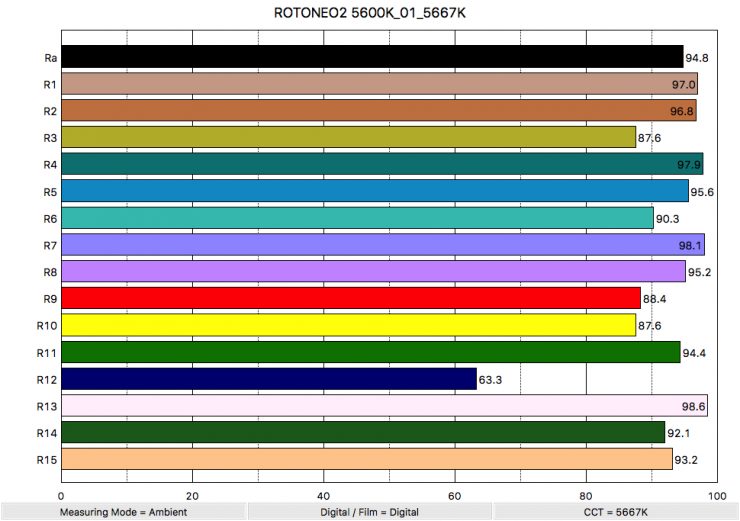
Above you can see the color rendering scores for the Rotolight NEO 2 when it was set at 5600K. The light had an average CRI (R1-R8) of 94.8 and an extended CRI (R1-R15) of 91.74.
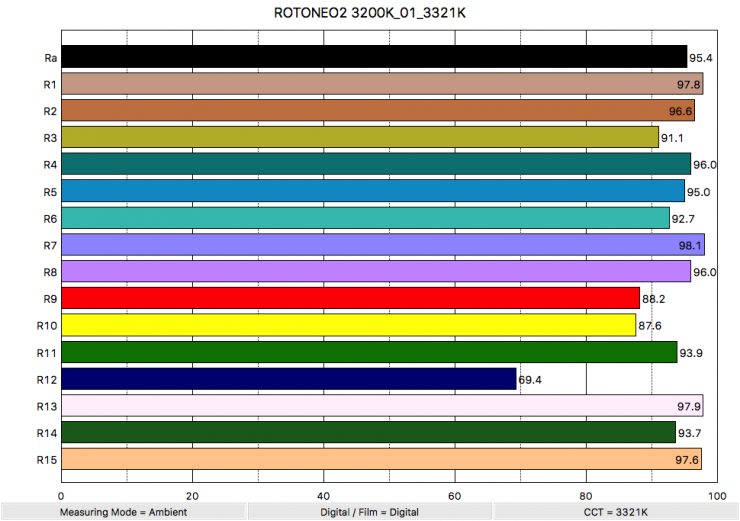
So how does the NEO 2 perform at 3200K? Above you can see that the light recorded an average CRI (R1-R8) of 95.4 and an extended CRI (R1-R15) of 92.77.
So let’s look at a summary comparison between the Vibesta Peragos Bi-Color and the Rotolight NEO 2.
5600K
| Vibesta Peragos Bi-Color | Rotolight NEO 2 |
| Average CRI: 96.1 | Average CRI: 94.8 |
| Extended CRI: 95.05 | Extended CRI: 91.74 |
3200K
| Vibesta Peragos Bi-Color | Rotolight NEO 2 |
| Average CRI: 96.8 | Average CRI: 95.4 |
| Extended CRI: 95.37 | Extended CRI: 92.77 |
Both lights perform well when it comes to color rendering scores. While the Vibesta has higher scores you would be hard-pressed to tell the difference between any light that scores in the 90s.
From my testing, the Vibesta Peragos RGBWW is not nearly as color accurate as the Bi-Color or 5600K Daylight versions.
Spectral Distribution
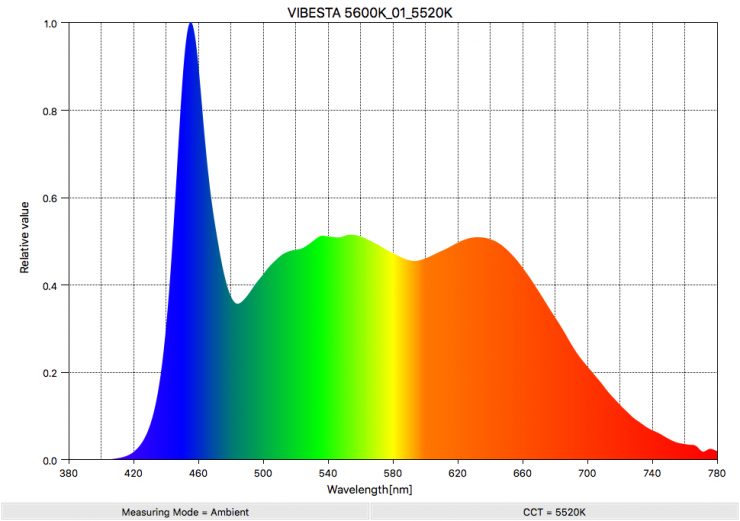
Above you can see the spectral distribution of the Vibesta Peragos Daylight 5600K. The light has a nice full color spectrum for a 5600K fixture with no large spikes.
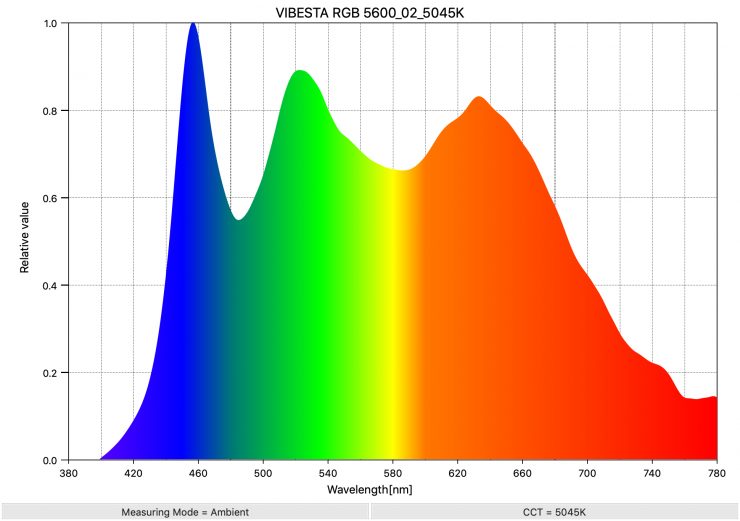
Above you can see the spectral distribution of the Vibesta Peragos RGBWW when used at 5600K. The light has a really nice full color spectrum for a 5600K fixture but it does have a few very noticeable spikes.
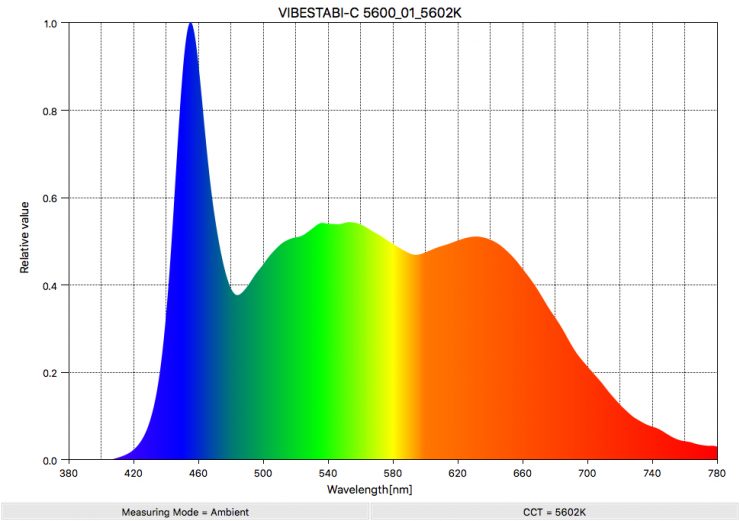
Above you can see the spectral distribution of the Vibesta Peragos Bi-Color when used at 5600K. The light has a nice full color spectrum for a 5600K fixture and no big spikes.
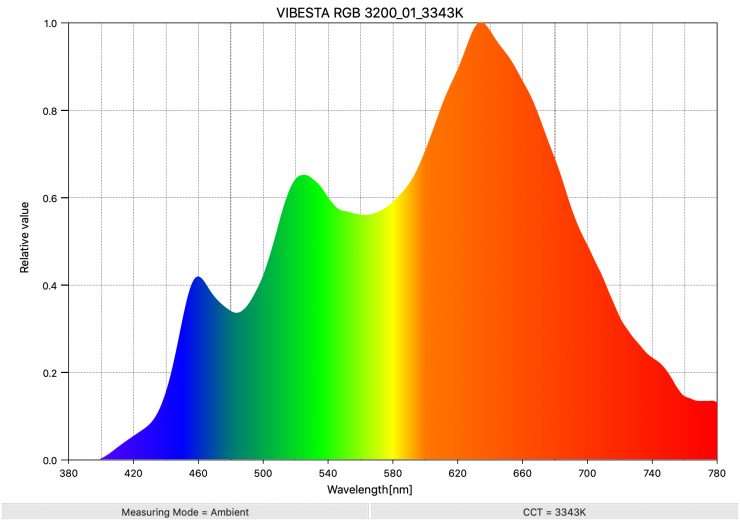
Above you can see the spectral distribution of the Vibesta Peragos RGBWW when used at 3200K. The light has a nice full-color spectrum for a 3200K fixture but there is quite a noticeable green spike.
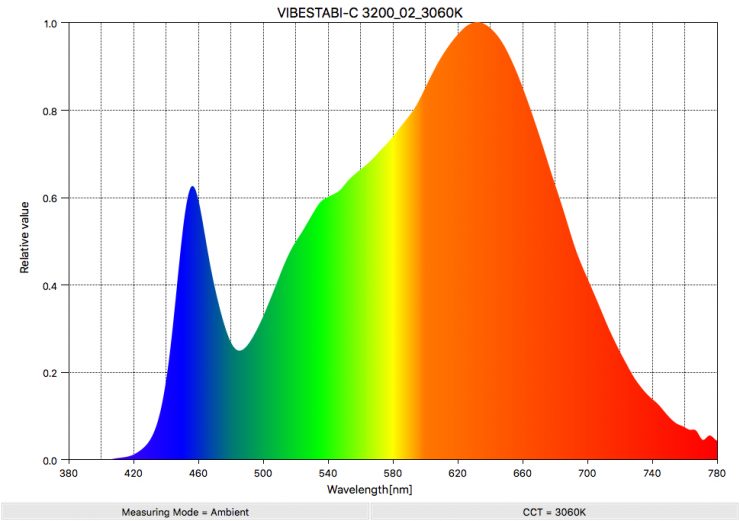
Above you can see the spectral distribution of the Vibesta Peragos Bi-Color when used at 3200K. The light has a nice full-color spectrum that is very smooth.
So how does that compare to its closest competitor the Rotolight NEO 2?
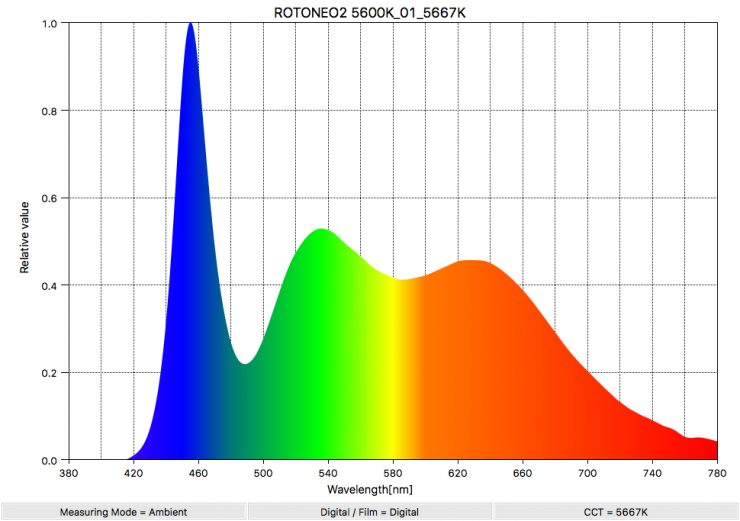
Above you can see the spectral distribution of the Rotolight NEO 2 when used at 5600K. There are plenty of gaps in the spectrum and a small green spike.
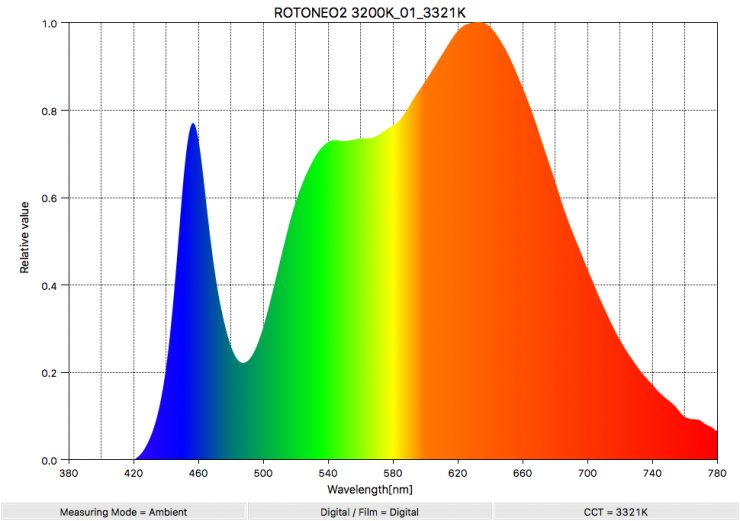
Above you can see the spectral distribution for the Rotolight NEO 2 when used at 3200K. The light does have a spike towards green.
From my testing, I found that Vibesta Peragos Bi-Color has a better spectral distribution than the Rotolight at both 3200K and 5600K.
SSI
SSI (Spectral Similarity Index) was developed by the Sci-Tech Council of the Academy. SSI gives me the ability to set any light as a standard, or use predefined standards (such as CIE D55), and then give other lights an SSI score based upon how well they will match standards such as CIE D55 measure spectral response and compare it directly against an ideal light source.
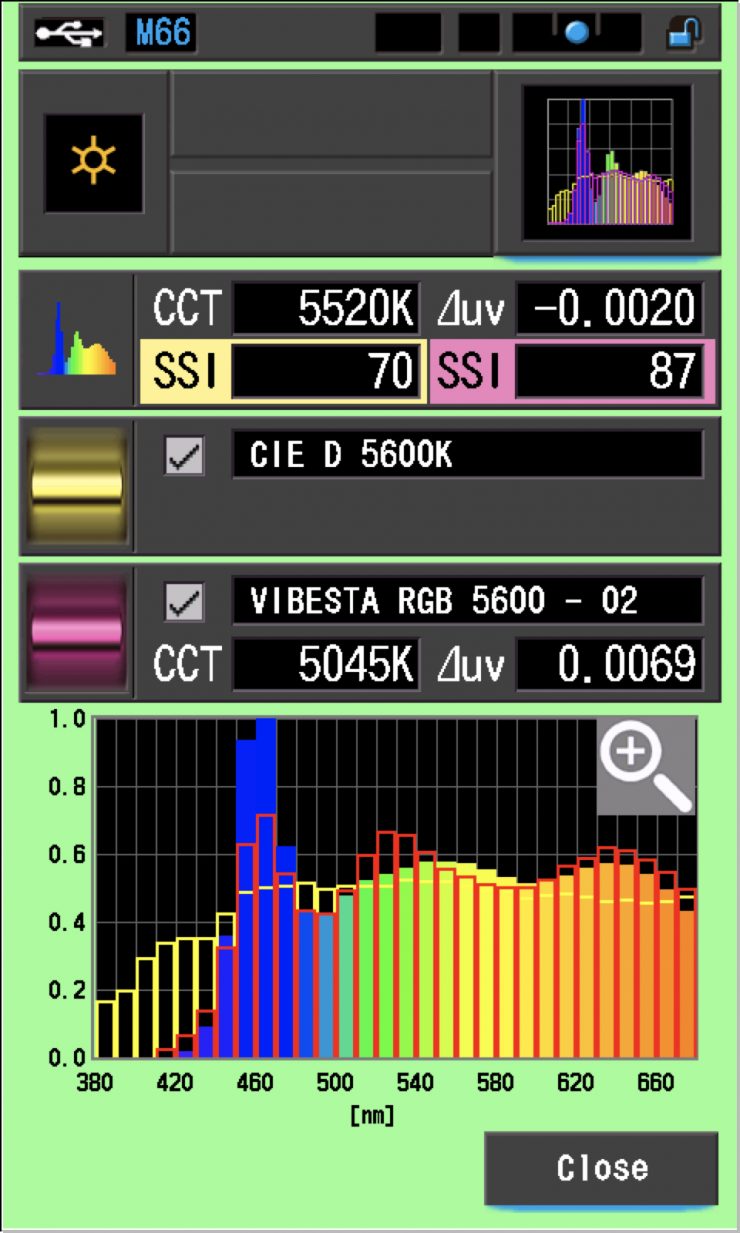
In this graph, the Gold bars indicate a perfect 5600K source. The Red bars show the spectral response of the Vibesta Peragos RGBWW when used at 5600K.
SSI is very useful to see how well different lights will play together. In the graph you just saw you can see that the 5600K Daylight only version of the light doesn’t actually do that good of a job if you are trying to match it to the RGBWW version. It scored 87/100. The 5600K Daylight only version when compared to a perfect daylight source only scored 70. Tt is important to note that most LED lights only record SSI scores in the 70s when they are used at 5600K.
So, let us see if the 5600K Daylight only version does a better job of matching the Bi-Color version when it is also set at 5600K.
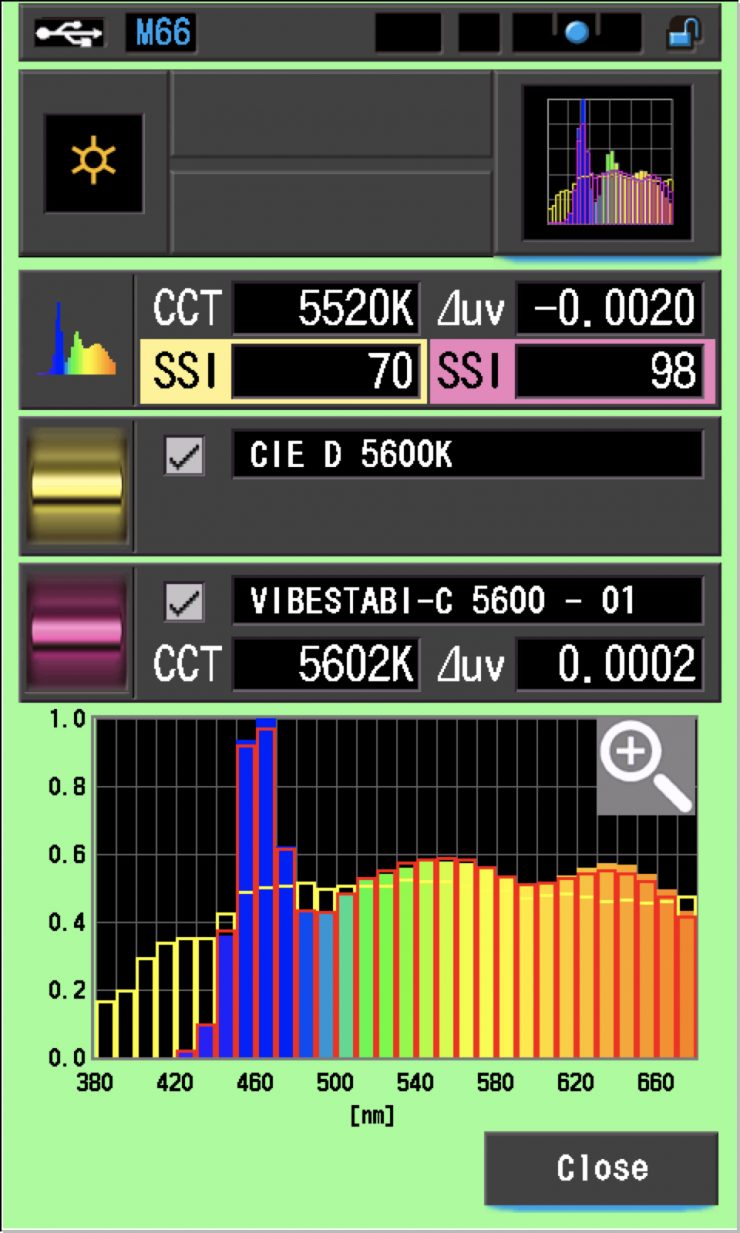
As you can see, the 5600K Daylight version and the Bi-Color version when used at 5600K are almost a perfect match.
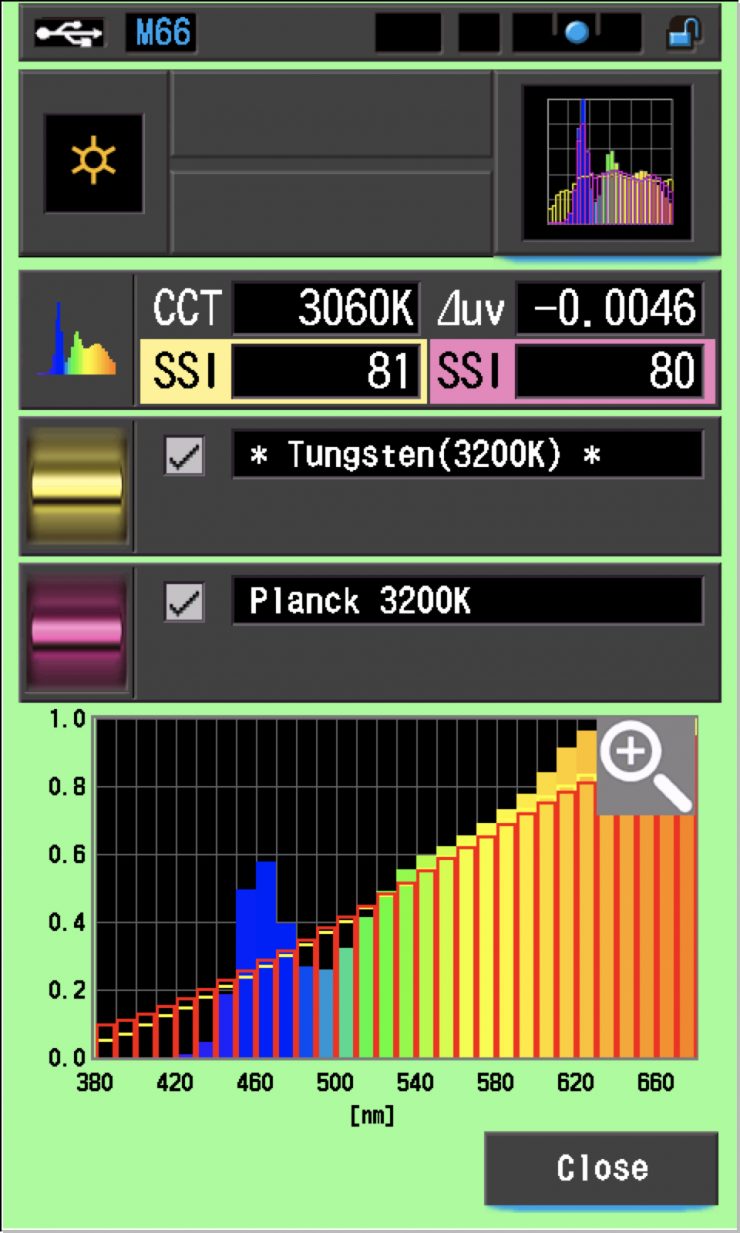
So how does the Bi-Color version compare to a perfect 3200K? Above you can see that is scores 80. A score of 80 is what I would expect from a 3200K LED light.
What does the quality of the light look like?
I have been using the Peragos lights for quite some time waiting to publish this review.
The lights are versatile, easy to power, and easy to use. I actually use them quite a lot when I am shooting product shots for a lot of the reviews we do on the site.
Given the current Coronavirus situation, it is very hard to show you a lot of real world examples using the lights.
Price
The Peragos lights are available for the following prices:
- Peragos Disk 304P (daylight only) $149 USD
- Pergos Disk 304 B (Bi-color) $160.72 USD
- Peragos Disk 30C (RGBWW) $229.99 USD
These prices are very competitive given how much competition there is out there.
The Peragos Disk lights are more affordable than the Rotolight NEO 2. The Pergos Disk 304 B (Bi-color) version which is the closest match to a Rotolight NEO 2 is $88 USD cheaper.
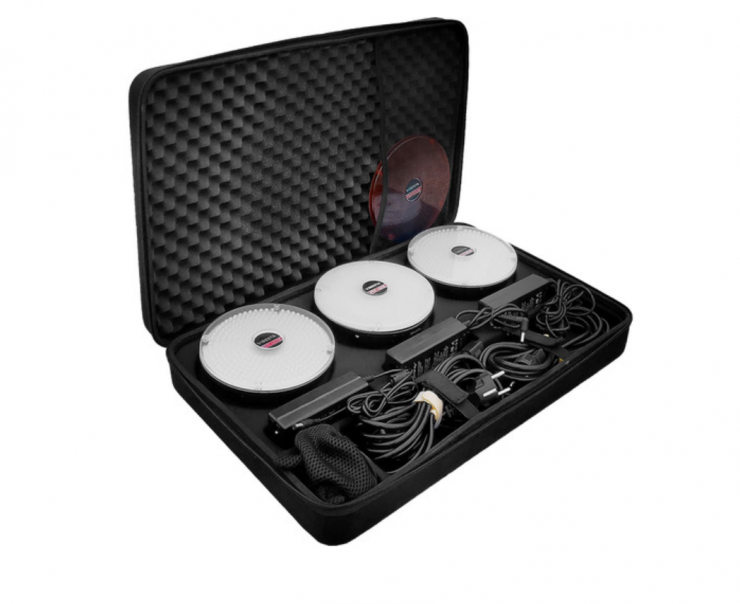
Vibesta is also offering a range of kits. Below are just some of the options available.
- Vibesta Peragos Disk 304P/304B/30C 3 Light Kit With Case/ Ac Adapter/ Mains Cable $499.99 USD
- Vibesta Peragos Disk 3 Light Kit with 2x 304P and 1x 304B Plus Case, AC Adapter and Mains Cables $429 USD
- Vibesta Peragos RGBWW Disc 30C 2-Light Kit $579 USD
- Vibesta Peragos RGBWW Disc 30C 3-Light Kit $799 USD
Accessories
You can buy a softbox ($39 USD) for the lights as well as a case that comes with light stands ($169 USD).
Mix & Match
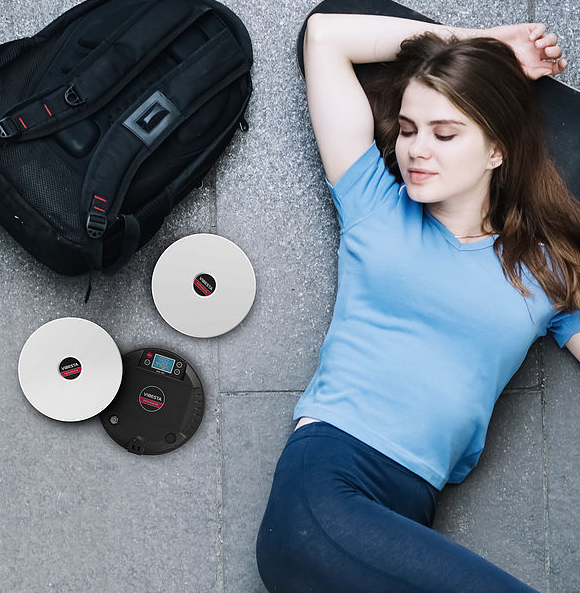
The nice thing about the Peragos lights is that you can mix and match them to come up with a kit that best suits your needs. If it was me I would probably build a kit of either 1x daylight version, 1x Bi-color version, and 1x RGBWW version. Or I would also be tempted to just go with 3 x daylight versions for the output they have.
Competition
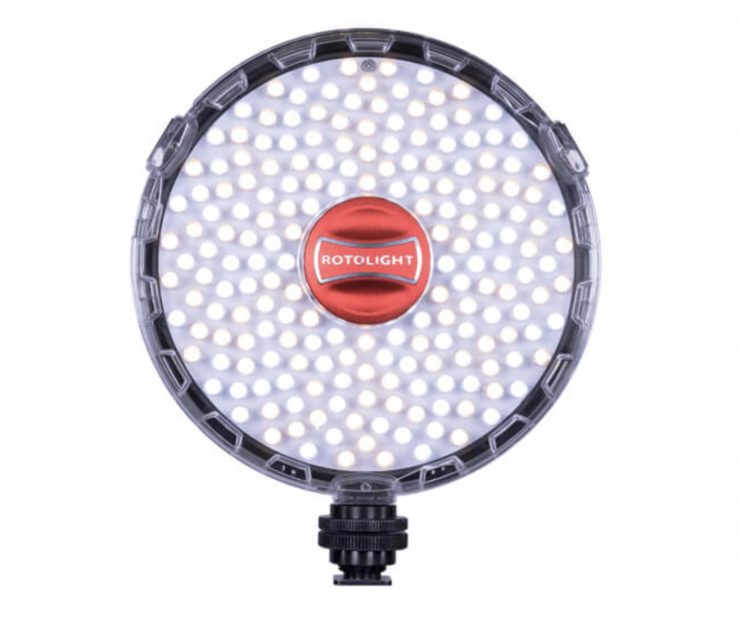
There are a lot of options when it comes to small, compact LED lighting fixtures that can be bought separately or in kits. Vibesta’s main competition comes from lights such as the Rotolight Neo 2, Manfrotto Lykos, Fiilex P360, Manfrotto Croma 2, Fiilex P101, Cineo Matchbox, Aladdin A Lite, and Luxli Viola 2. You could probably also throw the Litepanels Caliber in there as well.
The Luxli Viola² 5″ On-Camera RGBAW LED Light is the only RGBWW light among all of the competition. There are so many small, compact lights available it’s impossible to list them all.
As far as price and what you get, here is a list of how they all compare:
Rotolight NEO 2 LED Light Kit with Barndoors $248 USD
- Filter Pack
- Filter Holder
- Rotolight Aluminum Barndoors for NEO
- Shoe Adapter to 1/4″ Male Stud
- RL-NEO-PSU AC Adapter for NEO LED Light
- Belt Pouch Carry Case
- Limited 1-Year Warranty
Fiilex P360 Pro LED Light $395 USD
- Variable Color Temperature: 2800-6500K
- CRI/TLCI 93/96 at 5600K
- Increased Brightness Compared to Gen.1
- Beam Angle: 65° (Native)
- Aladdin A-LITE Bi-Color Dimmable Light Fixture (3000 to 6000K)
- Micro-USB Cable
- Diffusion
- Limited 1-Year Warranty
Luxli Viola² 5″ On-Camera RGBAW LED Light $239 USD
- Shoe-Mount Ball Head
- NP-F550-Type Battery
- Battery Charger
- Limited 1-Year Warranty
Litepanels Caliber $412.30 USD
- Caliber LED Fresnel
- Manfrotto Pixi
- Gel Frame
- Gel Set (1/2 CTO & 1/2 CTB)
- 4-way Barndoors
- AC Adapter with International Plug Set.
Conclusion
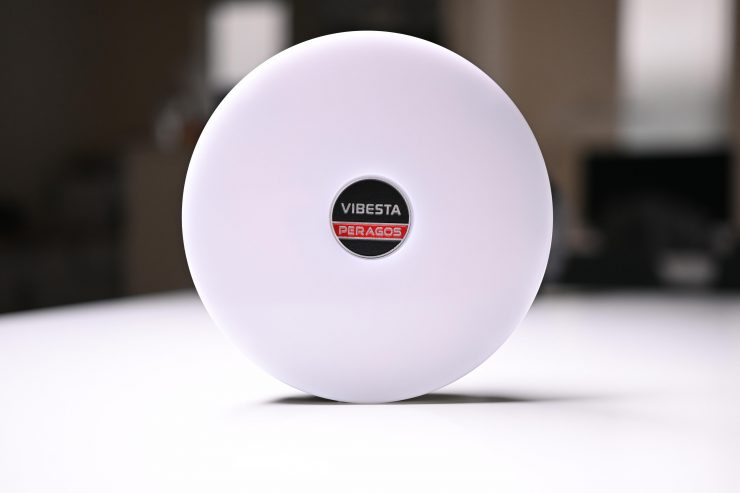
The Vibesta Peragos lights perform well. As far as price v’s performance is concerned, they are hard to beat.
I like that Vibesta has given you the option to buy three different versions depending on what your needs are.
As a small travel light, the Daylight 5600K makes a lot of sense. It has enough output that it could be used for sit down interviews as a key light. Having a very narrow 30-degree beam angle works well for an interview scenario where you don’t want light spilling everywhere.
I really like these lights. If you are looking for a small, compact lighting solution they are certainly worth having a hard look at.
Like what we do and want to support Newsshooter? Consider becoming a Patreon supporter and help us to continue being the best source of news and reviews for professional tools for the independent filmmaker.

